#and here we are with a textbook example of telling vs. showing
Explore tagged Tumblr posts
Text
Today, on Things Fantastic: Rereading a series you read years ago and discovering Your Guy™ in scenes and places you'd forgotten about. 100/10 on Google Reviews.com
#on to flight of the Eisenstein#and had entirely forgotten about the interaction between Tarvitz and Garro before things go to shit#and we actually get some extra bits of Tarvitz description and personality#james swallow dishin' out the goooods#related: forever wishing galaxy in flames was better written#so. much. important. shit. happens.#and here we are with a textbook example of telling vs. showing#this will be largely incoherent to 99.9% of people#but my ask box is VERY open to discussing the horus heresy series because i have Large Opinions™#40k launched my shit into orbit again
9 notes
·
View notes
Text
Can we kill therapy-speak in fanfic?
Don’t get me wrong here. I’m not saying your characters can’t be familiar with therapy keywords. But the use of it in fanfic is just killing off any sort of real, emotional stakes in certain fics. *cough* the my hero fandom
I’ll be real with you; I don’t want my characters to approach a situation with an acute awareness for any possible triggers or emotional responses in an attempt to build rapport with another character who has experienced severe trauma and/or abuse. And sure, let’s say that it is a professional, whose job it is to approach these situations. That doesn’t mean you have to write them like a mental health textbook vs a textbook victim of trauma.
For example; “Aizawa stepped back, not wanting to trigger any sort of trauma response from the abused teenager.”
Yeah, sure. Aizawa is a professional who, as a professional hero, probably has education in dealing with situations like this. But the way it is written is clinically detached, cold, and also way too professional from a man who has probably attended a total of one therapy session on mandate after witnessing the death of one of his best friends (which he never got over btw).
When you want to write a character who is attuned to other people’s needs and fears, try using less therapy bingo words, and be more descriptive of the emotions of the scene.
Instead; “Aizawa carefully stepped backwards, attempting to show he meant no harm. He knew how easy it was to scare a starving alley cat, you would be surprised how the same logic applied to a starving teenager.”
See? Isn’t it so much more soulful? So much easier to connect with? Sure, the first passage got the point across: Aizawa is aware that the kid he’s approaching is likely a victim of something traumatic, so he is approaching it as such. But the average human doesn’t have the dialogue of an occupational therapist, so writing situations like the characters are occupational therapists, kills off any sort of relatability for readers who don’t attend weekly therapy sessions. And even for people who do, it feels more like sitting in the armchair instead of absorbing yourself in the worlds and stories you’re trying to tell.
I’m not saying to ditch the mental health awareness altogether. Sure, having emotionally stunted characters create for interesting stories, but you can tell just as compelling of a story without having to resort to textbook wording. Instead, use that therapy foundation to build something more around your characters. Because using the therapy speak is just the same as telling, and not showing.
With that, good luck with your next hurt no comfort fic, and happy writing!
#fanfic#writing advice#writing#fanfiction#my hero academia#mha#mha fanfic#aizawa shouta#shouta aizawa#aizawa fanfiction#dadzawa#aizawa adopts izuku#vigilante deku#vigilante deku au#fanfic writing#writers on tumblr#writers on ao3#writerscommunity#writers and readers#writers and authors#author#authors#author advice
59 notes
·
View notes
Note
favorite things to write about?
Hello 👋
I hope things are going well for you. Thanks for getting in touch ! 💖 (Take care, sweetling, in case you decide not to read the post, at least you hear it now lol. And don't hesitate to share what you like to write as well !)
I am a fan of writing descriptions. So… how about we make a blog entry about it ?
HOW TO... MAKE A GOOD DESCRIPTION
A good description of a space gets all five senses going. For example, if I'm describing a bedroom, I might talk about the furniture placement or the curtains (what I see), the sound the floorboards or tiles might make (what I hear), if the floor is cold (what I touch), or if the room smells musty or has a specific odor (what I smell). In this example, I don't have to worry about taste, lol. It's just like real life: when we walk into a room, our whole body is involved. However, if it serves the plot to emphasize one particular sense, just do it.
If we use metaphors or comparisons, they have to represent the character they follow. That means sticking to their level of world knowledge, vocabulary, and language use. If someone lives in the city and has never been to the countryside, they probably won't use comparisons specific to it. They might do so using phrases like "He thought that must be what wheat looked like." Using the verb "thought," which expresses an opinion, makes the uncertain comparison seem valid because it's presented as perceived rather than factual. Also, descriptions are rarely just factual. They got a lot of emotional depth. This appreciation can be explicit or implied (e.g., pathetic fallacy). And often, this comes through in the use of figures of speech, like comparisons, metaphors, and personifications.
Stick to what's essential. It's not so much about saving time, but more about being practical. Everything in your text has a purpose. Descriptions should do more than just let readers imagine what you're showing them; they should also explain why what they see is important. For example: If your main character (MC) walks down a hallway with photos but doesn't stop and look at them, don't go into detail about the photos. No one will care. BUT, if MC spends a lot of time in their bedroom, it might be interesting to show their "living space" to help the reader understand who MC is and why they stay in their room. This can help the reader connect with the character and understand the plot better. Gentle reminder: keep your story flowing. That doesn't mean it has to be a bunch of actions, but the general rhythm should stay the same. A descriptive moment, which is basically a "pause in the action" because of its reflective nature, has to serve a purpose and shouldn't be gratuitous.
Showing vs. Telling. I have mixed feelings about this approach to writing. It's personal and reflects MY own style, so I'm speaking from MY perspective. I like it when things have a name. I use "telling" a lot, but I use "showing" a lot too, as a process. For example, when I write about fear, I'll describe the states my character goes through and end with "he was afraid." Yeah, okay girl, we get it. If I've given a clear enough description beforehand, this shouldn't be an issue. But I've noticed that ending a passage with its name makes it more emphatic and cuts out any doubt. It's not anxiety, and it's not terror. It's fear—nothing else. This helps me create the effect I'm going for. My character basically goes through phases, analyzes them, and draws conclusions (but that's just because I write sci-fi lol).
CONCLUSION: All these tips should help you write descriptions that give an ATMOSPHERE to your text. The choice of words and narrative voice ensure that your prose is SOMETHING OTHER THAN a biology textbook (but no offense, i love biology ).
BONUS: Here's an example of one of the last descriptions I wrote (which I unfortunately had to translate...):
Auxanne complies. Her steps make the staircase boards creak. She no longer remembers which step to avoid to prevent making noise, so she presses a bit harder than necessary on each one to try to compose a new score of silence. She ignores the photos covering the walls, closes her eyes to the portraits of Julien embracing her in some of them. When she closes her bedroom door, the young girl can't tell if the sad squeak she hears is coming from the rusty hinges or from her single sob that was almost immediately stifled.
It hurts to be here. It's hard to return. But she says nothing, she cannot. So her eyes embrace the room in its entirety, taking in the patchwork on the bed, the stains on the curtains, the beanbag in the upper left corner. There's even still the jacket (too small now) that she left during her last visit five years ago. The only real change she notices is the bath towel placed on the bed and the dust that seems to have frozen on the window frame. Auxanne timidly advances into the room then drops her bags on the floor. Then she lets herself fall flat on the mattress, which gently sags under her weight.
Eyes fixed on the peeling paint on the ceiling, she can't help thinking about her brother and the unfathomable void he left in her young heart. She still doesn't grasp what happened, didn't see it coming. And in the middle of this child's bedroom drowned in memories, sheltered from the bustle of the hallway where footsteps scrape against the floorboards, Auxanne remembers how alone she has felt since Julien's suicide.
#creative writing#novel writing#writer blog#writing#writing process#writing help#writing resources#about books and writing#writing advice#writing tips#writeblr#writing a book#fiction writing#resources for writers#writing resource#writer of tumblr#writer problems#writiers on tumblr#writerscommunity#essay#how to write#writer things#writer tips#writersociety#writing blog#writing tips and tricks
41 notes
·
View notes
Text
Cinematography?? In MY BL??? Not as likely as you think.
TLDR: it's a joke!!! but also legit sometimes I see "cinematography in bl" and it's just some basic pictures with mid-tone lighting and blue t-shirts. Let's talk film terms like: aperture, panning, tilting, and movement in film so we can see what goes into cinematography (with sources!). Also if I name a show you like as "boring cinematography" don't send me hate mail I'll laugh
(examples used: Our Skyy2 vs kinnporsche, 2gether vs semantic error, 1000 Stars vs The Sign)
If I name a show you like in this post as "bad cinematography" be chill about it, like, I ain't saying you can't like it, I'm just talking about techniques here not personal likability or overall show quality. I like badly filmed shit too say hello to my collection of Friday the 13th Blue Rays we're just here to talk techniques and like, educational stuff okay?
So the straight (heh) textbook definition of "cinematography" is: the art of making motion pictures. Which, frankly, tells you nothing. Like it's not wrong~~ but it's not informative either. Cinematography covers a lot of what we, the audience, visually see on screen:
"Cinematography is the art of photography and visual storytelling in a motion picture or television show. Cinematography comprises all on-screen visual elements, including lighting, framing, composition, camera motion, camera angles, film selection, lens choices, depth of field, zoom, focus, color, exposure, and filtration." (source)
So let's talk movement in film.
So when I talk about movement, what do I mean? I mean the way the camera, the characters, and the environment moves within a frame.
This video on Akira Kurosawa's usage of movement in a scene is brilliant:
youtube
Something as simple as having rain or fire in the background of a shot can enhance the emotions of a scene vastly. it gives the scene depth - literal depth, not narrative depth - that would otherwise be missing.
The way the camera moves and transitions leading the viewers eye back and forth makes what you're watching more engaging. You aren't consuming these scenes, you are engaging with them. They are apart of the story itself, giving the environment life and texture so the characters within them matter more.
And, look, I get busting out Thee Akira Kurosawa might be unfair, but if we're gonna talk cinematography we can't not talk the importance of movement on film.
To understand good cinematography you have to understand what makes it good and as such what makes bad or mediocre cinematography.
In connection with movement we gotta talk about camera techniques like panning and tilting:
youtube
"Camera movements are a fundamental part of video production. They can be a powerful storytelling device, heightening tension, evoking emotions, and bringing the viewer into the action. Without saying a word, camera movements can transform a scene’s entire narrative, and direct audiences’ attention where you want it." (source)
So we have movement of environment, of characters, and we also have movement of the camera itself.
Ok so like, where does the BL come in Pikachu??
I'm getting to that, I'm going to start with a more general example: Our Skyy 2 (Bad Buddy meets 1000 Stars edition) vs Kinnporsche.
youtube
Starting at 5:17 we have Pran stranded or whatever, and this shot is like, it's fine. It's boring as hell, but fine. Why is it boring as hell? Well it's flat, it lacks movement, it lacks depth.
When the driver drove off the camera could have panned to follow his movement and then panned back to Pran at a different angle to showcase his isolation. Honestly since the scene starts with a mid close up of Pran, I would have had the camera behind Pran as the driver drove away, and had the camera pan around Pran 360 so we get shots of his environment, and him, while also emphasizing holy shit he's like, fucking stuck in the wilderness.
In general, there's a big lack of movement in the scene. The camera remains almost entirely static, there's no attempt at zooming in or out, following Pran's movement, or showcasing his environment in any meaningful way. Even when Pran begins walking towards the camera the angle of the framing is still centered, rather than tilted downward or upwards to give us more dimension (non-BL comparison, the Book of Eli starring Denzel Washington does the "walking towards the camera" shots really well).
We get a cut of a medium close up of Pran, with a deeper focus so his environment is blurred out.
I understand the thought process of this shot, we want the audience to focus on Pran, but if the point of the scene is to emphasize he's alone, confused, maybe even a bit anxious at his new circumstances it could've been done better. Take a wider shot from this angle, open up the lens to allow for that background environment to come through and show him isolated. Maybe do a pan above him or tilt the camera up going from his feet up as he nervously ruffles his hair. There's options here.
This just adds more walking to the scene, which we already had. It doesn't enhance or emphasize anything about Pran's emotions as a character.
Anyway the camera continues to follow him and then we get another cut. And it's from the same angle as before, only this time we see a truck coming. The camera remains static, it completely stops moving, and we just wait for the truck to drive into the frame.
This whole sequence of events ends at 5:57 and while not a long sequence I find it frustrating because it's boring. The only way the audience knows that Pran is anxious is via Nanon’s acting, there’s nothing in the filmmaking that enhances or contributes to that feeling.
He’s alone, until he’s not, and that’s all the scene tells us. It leaves the scene lacking any tension as well, because we’re not getting a sense of isolation - how large is this space? How alone is Pran right now? What is the entirety of the environment?
Contrast this with a similar scene in kinnporsche ep06 where Kinn and Porsche are alone in the mountains. I don't have a video of this specific scene so I have to link the trailer, starting at 1:48 to 1:52, but see how we start mid-close up of Kinn and Porsche, then pan out from above them? This is a better showcasing of just how vast the environment around Kinn and Porsche are.
They're still center frame throughout all of this, the depth of the scene is in mid-focus so nothing is blurred out and you can see the sharpness of the environment.
It also places the audience in the same space as Kinn, who is looking up at the sky while the audience looks down at him. It makes the audience a more active participant in the shot, emphasizes the state of the characters, gives the audience a sense of space & environment, and relies a sense of emotion.
The additional fast zoom out also adds to the scene by adding movement and making it more dynamic.
youtube
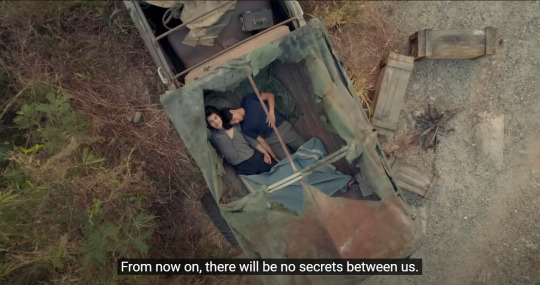
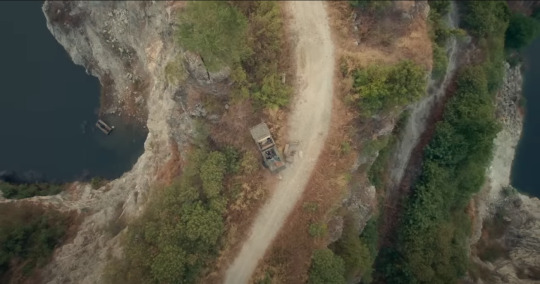

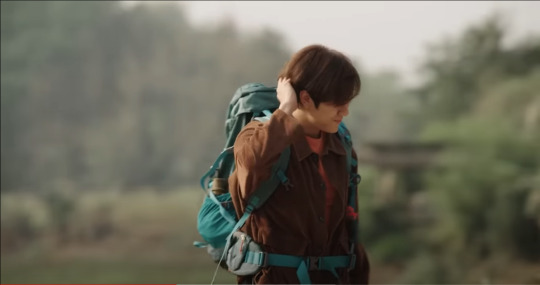
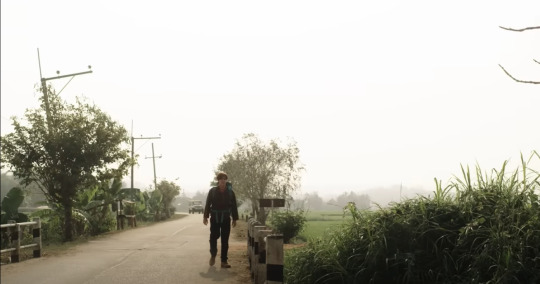
(my man pran looking like this 🧍)
Both these scenes are pretty short, but they're relaying similar information and one is way more dynamic and effective than the other. Both Pran and Kinn/Porsche are alone in the wildness, but in the latter there's a lack of space, a lack of movement, and a lack dimension. This is mainly a framing issue, so let's talk more about camera movement (panning, & tilting).
Here's a scene from 2gether vs a scene from Semantic Error.
youtube
(saw someone say 2gether had a high production value and chepie where??)
This entire scene with Sarawat and Tine is flatly shot. There is nothing in their background so no outward movement is happening, the lighting is even as are the colors, everything is at the same depth, and there's little to no motion in the camera.
The scene with Sarawat pushing Tine into frame. Why doesn't the camera follow Tine's motion of movement so the scene has more momentum? It just stops and the char falls out of frame before walking back into it. Then we get a series of cuts back and forth of close ups on Sarawat and Tine's faces. Back and forth, back and forth.
The editing leaves a ton to be deserved because if the back and forth did a quick pan back and forth with each beat we could build up tension, give the scene some texture, heighten the intensity of the argument. If we're going for something softer we could place them in on better set, or make the characters move themselves - have Sarawat walk away from the argument up those stairs, have the camera follow his movement as Tine chases him continuing the argument - or play with the lighting a bit, pan the camera down or tilt it something!
When Tine kisses Sarawat why doesn't the camera move with him in a more notable way? Why did we have a cut to a close up? And then we're back in a mid close up and more cuts and this editor is killing me!
This scene is 4mins long and the only engaging bit of filmmaking here is when the camera follows Tine when he steps closer to Sarawat putting the latter in the frame at 3:15, the entire scene is 4 minutes long.
I want to compare this scene to this scene in Semantic Error which is also all dialogue and also obviously filmed on a shoestring budget.
youtube
So right away the camera work here is smart, it starts off in an establishing shot, evenly lit, of Sang Woo and Jae Young both in the frame. Then we get a mid close up of JY looking down, then a tight close up of JY looking up.
The change in camera angle emphasizes his surprise at seeing SW here as he looks up at SW. The lighting has also changed, it's much brighter now. The camera also begins to move, where it was static before it begins to tilt and shift.
We get a cut to SW, the first one of this scene. JY is seeing SW in a new light for the first time, and as such so is the audience. By starting the scene off in an outward shot with both chars in the frame, they are placed on the same level and the audience doesn't see their expressions up close. So when we're hit with JY's close up of surprise and then SW's close up of his wet hair it holds way more impact. It enhances the feelings of JY's character for the audience.
The lighting behind SW has also changed, it's much brighter, and warmer compared to the cooler tones of light behind JY. The camera also slows, and continues to to tilt and shift. JY's world has literally been shifted on his axis.
We get another cut, this time medium on SW and notice, the camera stops moving for that moment and the light around him dims. It's not as saturated. We're moved out of JY's pov here and back into "regular" framing.
SW tries to make JY leave, we get a close up cut of the cut on JY's arm - hey editing used to display important and new information! - then the camera cuts to SW getting medicine and here's a small but important thing, when he tosses at JY the camera follows his movement. And instead of cutting away, when JY gets up thinking SW is hurt, the camera follows JY's movement back towards SW.
It would have been easy to make a cut there back and forth - like in the 2gether scene did over and over - but following the movement of the characters makes the scene way more interesting visually to watch.
Changing the angles of the camera from a lower angle (where JY is looking up) to a downward angle (where SW is looking down) makes the scene more interesting visually as well and enhances the storybeat of JY looking up at SW in a new light memorized. This contributes to the story as well, as it's JY who catches feelings for SW first so their are literally, on uneven ground until they're not later in the story. The camera is panning, tilting, moving with the characters even given the limited space. The lighting adds to the effectiveness, as do the minimal cuts.
On a technical level, the scene in Semantic Error is just better filmed. In my own opinion, the scene is far more engaging b/c the filmmaking is better, where in 2gether the reliance is almost completely on the actors to sell the scene with little help. And I'm not saying nothing about Bright and Win cause their stans wildin'.
Next, I wanna talk about aperture.
I saw a post that used this word and I didn't understand the context in which they were using it because aperture isn't a style of filmmaking its a camera setting or lens adjustment - it's the rate at which the camera opens and closes letting in light and focus.
"Aperture is the opening of the lens through which light passes. When you hit the shutter release button to take the picture, the camera aperture opens to the predetermined width, letting a specific amount of light through. A large aperture lets more light in, and vice versa. Aperture is calibrated in f/stops, written in numbers like 1.4, 2, 2.8, 4, 5.6, 8, 11 and 16. The larger the number, the narrower the aperture." (source) <- really recommend this article if you want to learn about aperture in film.
A great non-BL example of aperture used for style is One Piece Live Action where cinematographers Nicole Hirsch Whitaker, and Michael Wood love using deep focus aperture in a lot of scenes.
But let's compare The Sign vs 1000 Stars.
youtube
youtube
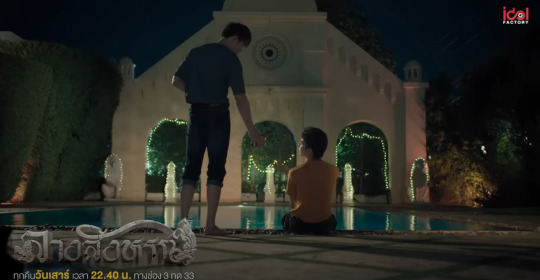

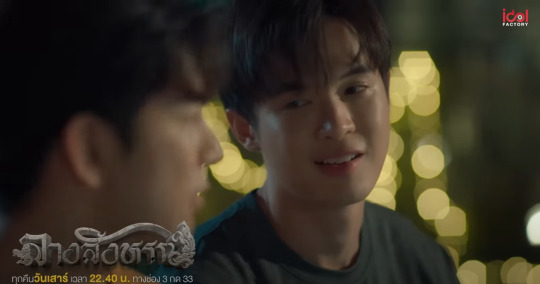
So when the scene starts, we're in mid-focus/aperture, everything is of similar sharpness and depth. Nothing is especially blurred out we're getting the full spectrum of Phaya and Tharn's environment.
When the camera switches to close ups of Phaya and Tharn however, we get a deep focus aperture. That's why everything behind them is so blurred out. In a close up of Phaya, even Tharn's face is blurred. The director wants the audience to focus specifically on these characters individually, so we can understand the weight of their dialogue. But when the camera wants us to see the characters as a unit, it cuts, pulls back out of that deep focus and everything is back in mid-focus again.
Here's another thing, it's subtle but it's important.
This scene also combines what we already discussed about movement. At :08 of the scene, in that first mid-shot the camera is actually zooming in closer on Phaya and Tharn. Not dramatically, subtly, but it is there. This is important, because at 3:23 we get another mid-shot of them, pulled out of that deep focus, and the camera begins to zoom out.
The camera also follows the movement of Phaya grabbing Tharn's hands, then pans back up to Phaya's face once again before panning higher into the frame and panning back to their faces and zooming in.
When we move back out of that deep focus, into a mid-shot the camera continues to zoom out on the two characters as they kiss.
I saw someone say that this scene wasn't "filmed like BL kisses" and, eh? Like it isn't filmed in that static style of filmmaking which has dominated BL filmmaking probably due to budgetary reasons. But
The Sign follows a similar filmmaking style as Kinnporsche and Domundi shows do. But also just like, basic filmmaking techniques you'd see in shows of the non-CW/soap variety.
The thing fans are seeing here is film technique (probably partially due to a larger budget). Movement, lens adjustment, panning and titling, lighting and color are all playing a role in this specific scene.
Cinematography baby.
(sidenote the VFX of The Sign is dope as fuck too)
Okay so let's talk Our Skyy 1000 Stars
youtube
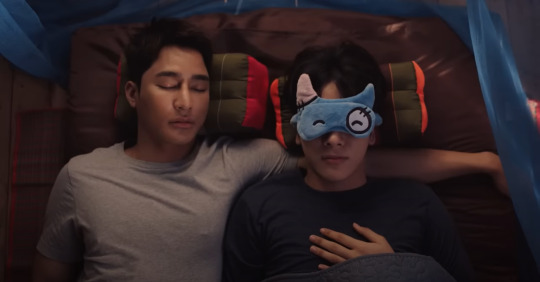
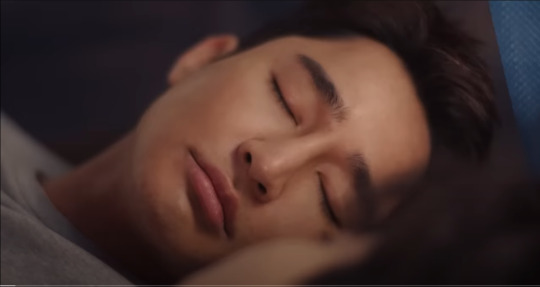
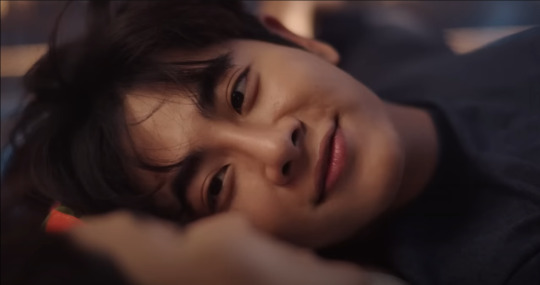
So this opening scene follows a similar structure to the scene in The Sign: mid focus shot of the two chars, into separate deep focus close ups. It's also a dialogue heavy scene like the one with Phaya and Tharn.
So why does their scene work better on a technical level than this one in Our Skyy 2?
The scene in The Sign combines techniques of aperture, movement, lighting, color and framing to give everything more impact.
In this scene with Phupha and Tian we get a similar editing style as the scene in 2gether: lots of back and forth cuts, very tight close ups, static camera movement. Where as the camera zooms in and out during mid-shots, the camera doesn't move in Our Skyy 2. It remains motionless even though a zoom in as the two characters lay in bed would add a lot to the scene itself.
In the close ups the camera continues to remain static, only changing angles when there's a cut. At 1:22 Phupha moves his arm to wrap around Tian, the camera could have taken a closer shot at his arm, and then followed his movement as he wraps it around Tian. Like how the camera followed Phaya's movement when he holds Tharn's hand.
Instead it's just a flat shot, we see his arm wrap around in a mid-focus above shot. The camera does move to follow Tian a couple times - at 1:50 for example. But overall, the scene is stiff - who sleeps like this frfr - in framing, in movement, in depth.
I want to say that I don't think this scene is bad - like I do the 2gether scene or the earlier scene with Pran - I think it's just, okay~~
And no, for none of these examples did I pick "the worst" shots or whatever. I'm not out to get any specific show, but tried to find comparable scenes and compare and contrast the filmmaking techniques used in both and how effectively they were used.
I want to leave off with this.
There's a lot that goes into cinematography, yes this singular shot of Furiosa is amazing, but what makes the scene amazing?

youtube
Pay attention to how the camera moves (panning and tilting), when the camera moves (zooms in and out), the movement of the scene (the hair and sand moving), the lighting (Furiosa from behind is in darkness, her side profile more lit), the depth of the scene itself changing (as she walks away from the group the focus/aperture gets deeper on her, then when she walks out of the frame it grows larger to focus on the characters left behind).
All these little things make up what is "cinematography". The more you learn about the techniques used the more you can notice about film and what makes a scene powerful.
As BL gets more budget we're seeing shows expand their filmmaking catalogue more and more. Which is exciting! If fandom is gonna talk cinematography I think it's helpful to have the vocab to do so, and it's cool to watch a scene and be like "oh I see what they're doing here and why and how".
I mentioned other things that go into cinematography like framing, lighting, color, and there's also editing (which is separate). Idk if I'll make a post about those things cause I'm lazy and this shit takes forever to research and write but who knows~~
Check out other posts in the series:
Film Making? In My BL? - The Sign ep01 Edition | Aspect Ratio in Love for Love's Sake | Cinematography in My BL - Our Skyy2 vs kinnporsche, 2gether vs semantic error, 1000 Stars vs The Sign | How The Sign Uses CGI | Is BL Being Overly Influenced by Modern Western Romance Tropes?
[like these posts? drop me a couple pennies on ko-fi]
#the sign#the sign the series#kinnporsche#gmmtv series#gmmtv#chaos pikachu speaks#chaos pikachu metas#fuckign a i should open a ko-fi this shit takes forever to write#pikachu's bl film series
164 notes
·
View notes
Text
✅ Complete Guide to Pivot Points: How to Use Them in Trading Like a Pro

Ever watched the Nifty 50 bounce off a level like it had a mind of its own? Or noticed how Bank Nifty reversed direction almost perfectly from a certain price? You may be witnessing the power of Pivot Points — one of the most widely used technical tools in the trading world.
This isn't some random line drawn on a chart. Pivot Points are calculated, tested, and used by traders around the globe — from Wall Street to Dalal Street. In this guide, we’ll break down everything you need to know about pivot points, how to use them in real trading, and why even professional traders in India rely on them.

🔍 What Are Pivot Points and Why Smart Traders Use Them Daily
Pivot Points are price levels used by traders to identify potential support and resistance zones. They are derived from the previous day’s high, low, and close — which makes them highly relevant for intraday traders.
They act as psychological markers, signaling where the market could reverse or continue its trend. Originally popularized in the floor trading era of the Chicago Mercantile Exchange (CME), Pivot Points are now used globally — including by Indian traders using Strike Money, TradingView.
📉 Example: On 5th April 2024, HDFC Bank stock showed strong intraday resistance at the daily pivot of ₹1,526. The stock reversed after failing to break that level multiple times — a textbook pivot point reaction.
🧠 How Are Pivot Points Calculated? (And Yes, It’s Simple Math)

The Standard Pivot Point formula is straightforward:
Pivot Point (P) = (High + Low + Close) / 3
From this base point, we calculate:
👉 Resistance 1 (R1) = (2 × P) – Low 👉 Support 1 (S1) = (2 × P) – High
These levels are extended further to R2, R3, S2, and S3 using variations of the range (high-low). Tools like Strike Money and TradingView automate these instantly.
🧪 Real-World Insight: A 2022 research paper by the National Stock Exchange (NSE) observed that stocks tend to respect pivot levels in 68% of intraday moves across midcap and large-cap segments.
🔁 Which Type of Pivot Point Should You Use? Here's the Breakdown

✅ Standard Pivot Points – Best for beginners and general market structure ✅ Fibonacci Pivot Points – Use Fibonacci ratios (0.382, 0.618) to reflect market psychology ✅ Camarilla Pivot Points – Focus on tighter support/resistance for fast-moving stocks ✅ Woodie’s Pivot Points – Give more weight to the closing price, preferred by some day traders
📊 Use Case: During a volatile session in March 2024, Infosys Ltd reversed sharply from the Camarilla L3 level — indicating mean reversion in a ranging market.
Tools like Strike Money allow traders to select these different pivot styles seamlessly, adjusting for volatility or timeframe.
📈 Using Pivot Points in Trading: Not Just Lines, But Strategy

So how do you actually trade with pivot points? Here's how traders apply them across strategies:
🔥 Intraday Range-Bound Strategy Stocks like TCS often trade within pivot ranges during low-volatility sessions. If price hovers between S1 and R1, a range-bound strategy using RSI as confirmation works best.
💥 Breakout Strategy When Bank Nifty opens above the pivot and surges past R1, it often signals a bullish breakout. This move is usually accompanied by volume and may run till R2 or R3.
🔁 Swing Trading with Weekly Pivots Weekly pivots help spot major trend shifts. In early 2024, Reliance Industries bounced off its weekly S1 pivot level, gaining nearly 5% in the following days — ideal for swing entries.
🧠 Combine pivot points with indicators like MACD, RSI, or Moving Averages to filter false signals.
🤔 Pivot Points vs RSI, MACD & Moving Averages: What Works Best?

📍 Pivot Points help identify potential price reversal zones based on past data. 📍 RSI tells you if a stock is overbought or oversold. 📍 MACD signals momentum shifts and moving average crossovers. 📍 Moving Averages smooth out trends over time.
They all serve different purposes. But when used together, they’re powerful. For example, if ICICI Bank hits a pivot support while RSI is below 30 and MACD turns bullish — that’s a solid setup.
According to Investopedia and research by John Person, combining pivot points with momentum indicators enhances entry precision by over 30%.
⚙️ Best Tools to Use Pivot Points in Indian Markets
You don’t need to calculate pivot levels manually. Several charting platforms offer built-in indicators.
📲 Strike Money – Designed for Indian traders, this tool offers clean pivot visualizations and support for Standard, Fibonacci & Camarilla pivots.
📲 TradingView – Global charting platform with extensive pivot scripts
🧪 Tip: Use pivot points with pre-market open levels to plan your trades. Stocks like Titan and Maruti Suzuki show excellent reaction near pivot zones right from market open.
⚠️ Common Mistakes Traders Make With Pivot Points
❌ Blindly placing orders at pivot levels Just because a level is there doesn’t mean price will stop — wait for confirmation.
❌ Ignoring news events Even if a stock sits near pivot S1, a negative earnings report can send it crashing through all levels.
❌ Using pivot points without timeframe context Daily pivots work for intraday, weekly for swing. Don’t mix them up.
⚡ Real Case: On Budget Day 2024, Larsen & Toubro (L&T) blasted through all pivot levels due to policy announcements. Using tight stops and volatility filters is key on such days.
🙋♂️ FAQs: Everything You’ve Wanted to Ask About Pivot Points
📌 Are pivot points better than Fibonacci retracements? Not better — just different. Pivot points give static levels based on the prior day; Fibonacci retracements are dynamic and based on swing highs/lows.
📌 Do pivot points work for crypto trading? Yes. Tools like TradingView allow pivot overlays on Bitcoin and Ethereum charts.
📌 What timeframe is best for using pivot points? Use daily pivots for intraday, weekly for swing, and monthly for positional setups.
📌 Are pivot points reliable? Yes, especially in range-bound markets. But they work best when confirmed with volume, price action, or oscillators like RSI/MACD.
🧭 Real Market Examples Using Pivot Points in India
📍 On 14th Feb 2024, Tata Motors opened near the daily pivot of ₹925. After testing support at S1 (₹918), it reversed sharply, closing the day at ₹935 — a perfect long opportunity.
📍 Nifty 50 Futures respected its weekly pivot level of ₹21,530 multiple times in March 2024. Traders using the Strike Money chart spotted this and positioned accordingly.
📍 During the Q4 results in April, Infosys broke below its S2 level post-earnings, dropping nearly 4%. A textbook example of a breakdown continuation through pivots.
🧠 What the Research Says About Pivot Points
🎓 A 2021 study by University of Illinois revealed that pivot-based levels coincide with significant liquidity zones — especially during the first hour of trading.
📈 NSE’s internal research shows pivot levels impact short-term price behavior in over 65% of stocks in the F&O segment.
🧑🏫 Veteran trader John Person, in his book "Candlestick and Pivot Point Trading Triggers", emphasizes combining candlestick patterns with pivot zones for enhanced accuracy.
✅ Should You Add Pivot Points to Your Trading Toolkit?
If you're an intraday or swing trader in the Indian stock market, ignoring Pivot Points is like ignoring speed breakers on a road — you're bound to hit something you didn’t expect.
They provide clarity, structure, and objectivity — especially when used on platforms like Strike Money, which visualizes pivots with market responsiveness.
Combine Pivot Points with strong indicators, volume confirmation, and market news — and you’ll trade with more confidence and less guesswork.
🎯 Ready to Level Up Your Trading? Try setting up Pivot Points today on Strike Money or TradingView, test them for a week, and you’ll see how these invisible levels often become the market’s most visible reaction zones.
0 notes
Note
During my rewatch, noticed how in the episode where Scott is feeling such guilt over Derek's apparent death that his body is refusing to heal, one of the words Stiles is quizzing Scott on is anachronism and how it seems relevant due to this episode being inter spliced with flashbacks.
And of course, I cannot NOT mention the BRILLIANT scene with Allison hallucinating Victoria. Her mother telling her to approach the problem unemotional and clinically, echoing Gerard who told her to attack the situation from a place of strategy vs emotion. How Allison is fully aware her mother wasn't a flawless person but still loves her and as you stated once, chooses to take strength from certain aspects of her. I have no doubts Victoria genuinely loved Allison and her always pushing her to be "strong" knowing the world(s) they occupy and what's expected of women in their family. And here she is, struggling to save the life of the same boy her mother tried to kill to keep her safe and ended up taking her own life because she was bitten. The love was definitely genuine, I could see it as Victoria tried to talk to Allison one-on-one but was told she was busy but rather than be upset she was disappointed and chose to die in her bed to be close to her.

One of the things I love so very much about Teen Wolf is how it was willing to push the boundaries in its storytelling conventions. One example of this that I've talked about before is the idea that it grounded its perspective in the experience of teenagers, none of whom were occult scholars, so some of the supernatural things they witnessed simply went unexplained. The adults who understood these didn't teach them the intricacies of the supernatural world either because it allowed them to manipulate the teenagers, as in Peter's case, or because they thought that the teenagers should be allowed to be teenagers, as in Deaton's case.
Unfortunately, in my opinion, sometimes it didn't work. They weren't successful when they focused an entire season on a character's absence (6A) or when the story's surprise reveals frustrated the audience rather than disoriented them, such as the Dead Pool's computer towers. On the other hand, I'd much rather watch a show which tried new things and fell on its face than one that stayed conventionally predictable.
But Frayed (3x05)'s experimentation with non-linear storytelling did not fall on its face, mostly because it used the fractured narrative to highlight essential aspects of individual characters that could get lost in the plot. It also helped that it dropped the audience enough hints to suggest that they not spent too much effort on the narrative mechanic and more time on what the mechanic brought to the story.
There were two hints. The first was that particular word that started Scott's vocabulary quiz --
Stiles: "Anachronism."
Scott: Something that exists out of its normal time.
The second was Lydia's textbook: Thermodynamic Asymmetry in Time. This is one of the basic building blocks of the universe: certain functions only go in one direction.
In my opinion, these point to the show -- there are certain characteristics (both positive and negative) that Scott and Allison show that are not dependent on events to motivate them. They exist within each character, and not only as a response to the horrors around them. By breaking up the narrative, we can isolate those particular traits.
Scott: It is this episode that I find definitive proof that Scott is motivated primarily, and forcefully, by compassion. The events of previous seasons came at Scott, he had to react to them. But in this case, the event has already came and went: Derek is dead. We see that Scott has compassion for Derek, perhaps too much as it becomes guilt, and that he is unwilling to use it as an excuse not to take action. By seeing his reaction to Derek's death before we learned the particulars of it, we can see he doesn't feel this way because he's being forced to by expedience. The deed is done; Derek is dead. There's no necessity for Scott to have to feel bad for Derek or to take responsibility for the aftermath. It is part of his nature.
Allison: For her part, I find this episode a refreshing statement that Allison may have been shaped by her parents but she's not their puppet and that Gerard's manipulation of her was an anomaly and not a real flaw. Without the burden of the linear narrative, we see Allison accept the teaching of her mother, which helps her save Scott from his overabundance of compassion, but she we also see her reject the teaching of her father (which, ironically, he is also rejecting). Allison, outside of the flow of events, is and will remain her own person. She's not being pressured to help because of external expectations but by her own internal concept of duty.
By randomizing the audiences experience of this particular part of the narrative, Frayed separates Scott from the pressure that certain events create in characters, allowing us to see that they are the way they are not only because of where they find themselves, but the way they act on the inside.
As you can no doubt guess, I'm very pleased with how it worked in this episode.
24 notes
·
View notes
Note
Hi, I noticed you did the MBTI types of the ORV characters, and I was wondering what you think the MBTI types are for the Revue Starlight gals :D
Anon, I want you to know that this google doc is 14 pages single-spaced, and I'm still not done.
WITH THAT BEING SAID, I'm so glad you asked!! I'll be breaking this up into four parts so we don't have to scroll through one massive wall of text. The other schools will take a bit more time to publish as I'm still working on a couple from each (I think I have four girls left!).
But without further ado:
Starira MBTI Part 1 - Seisho
Siegfeld
Frontier
Rinmeikan
I had a lot of help with all of this reading @HalfACape’s wonderful character analyses of so many of the girls on twitter, as well as consulting the Personality Database page for the characters I was less sure about (though there were a few I disagreed with on there - none in Seisho, we'll be discussing the others later). But everyone feel free to discuss if you disagree with anything!
Karen Aijo: ENFP
ENFPs’ dominant function is Ne (extroverted intuition) (that running gag Karen has in the game where she mishears words, spouting off suggestions even if they make absolutely zero sense to the situation at hand - “telescope? telephone? telenovella?” - is such stereotypical Ne). Ne is always running towards any possibility, no matter how unlikely it seems, and I don’t need to spell out for you how much of that we saw from Karen in the anime. Ne-Fi feed each other to create a rebel/free-spirit type of personality (Ne seeks all possibilities, Fi holds strong inner values and selfish desires - what do I want, what do I need? How does this make me feel?). Her Te isn’t too developed yet, which is fine because it’s tertiary and she’s still so young. That tertiary, undeveloped Te shows up in her scatterbrained, lackadaisical, go-with-the-flow attitude (but when dominant Fi gets fired up by something - like an old childhood friend coming home - it kicks Te into high gear). Inferior introverted Sensing shows no respect towards rules or regulations - see her revue with Junna (Si-dominant) and the anger she draws out of Maya for (a child of the system and traditionally hard worker) in their Revue of Pride. Karen is the natural rebel, the forever optimist, the sunshine girl - textbook ENFP.
Mahiru Tsuyuzaki: INFP
If you want to see what leading with an introverted function looks like compared to an extroverted function, compare Mahiru to Karen! They share the exact same functions, just flipped on the I/E axis. So Mahiru is Fi, Ne, Si, Te. Karen is Ne, Fi, Te, Si. And Mahiru is a very clear example of an INFP - such a warm, brilliant, awe-inspiring person, but can also be her own worst enemy and others tend to underestimate her. And it’s hard, I don’t blame her! Leading with Fi and not having that physical/in the moment Se to support it (like ISFPs do, just compare her to Kaoruko--yes--they’re only one letter off from each other) means that it’s extremely hard for INFPs to naturally advocate for themselves...so instead, they retreat into their own imaginations where it’s safer (Ne). BUT THEY’RE SO INCREDIBLE!! THERE’S SO MUCH THERE TO RESPECT AND ADMIRE!! *shakes her like maracas* IF YOU WOULD JUST SHOW US!!!!!!! (and this is her whole arc in the anime i don’t need to tell her lol). It’s actually so interesting how she and Karen’s Fi and Ne escapism manifests in their respective introverted/extroverted personalities. These two really are more similar than most of us think!
I love INFPs so, so much because they’re like sleeping giants. Once they get a hold of and develop that inferior extroverted Thinking it’s over - nobody else can compare. They’re like the characters in video games that start off super weak, and then you blink and suddenly they’ve become the most powerful units near the end of the game.
Kagura Hikari: INTJ
ENFP’s stereotypical partner (I swear every other reserved person A/sunshine person B couple in fiction is this type pairing) and while it’s tropey it works because these two types play off each other so well. I actually originally had her pegged as an ISTJ, but I think that her bullheadedness earlier in the anime is more indicative of Ni being stubborn. Hikari is cagey, reserved (tert Fi/inferior Se), and an incredibly high-achieving individual (dominant Ni sets specific goals, auxiliary Te implements). Her tertiary Fi (which INTJs LOVE to keep locked up, right here, forever, until they die) is so obvious as you slowly learn just how much of a sap/romantic she is. It’s her weaker Fi that holds that sentimentality towards Starlight after all these years, her Fi that struggles to hold on to that childhood promise, her Fi that has her following Karen (and eventually Mahiru as well) around like a duckling (though we initially get the impression that the dynamic is the other way around). She grows to care deeply for all the other girls around her and that’s all her tertiary introverted Feeling getting stronger as the story progresses! Like so many people in the fandom have realized, she isn’t a mean person, she’s just socially awkward. Not too much to say on her inferior Se, that mostly manifests in how she’s a homelier person who would rather stay in than go out, and doesn’t actively try to seek new experiences (this was what had me thinking ISTJ at first).
Junna Hoshimi: ISTJ
Karen’s polar opposite - they actually share the exact same functions, just in reverse! So Junna leads with introverted Sensing where it’s Karen’s weakest, and Karen leads with extroverted Intuition where it’s Junna’s weakest. And we see this play out in their revue!
Junna is one of my favorite characters in the series for a reason and it’s because it’s SO rare to see the ISTJ in a rebellious role. Si is all about following and respecting order, and Junna breaks all of that to create her own! We see that dominant Si show up in literally every other facet of her life, though - from her by-the-book attitude to her stringency with deadlines and tardiness to her respect for the creatives of old - Shakespeare, Nietschze, etc. She’s an incredibly bright and successful student as well (any type can be of course but the “kind of student” she is is very much Te supporting Si - super studious and placing heavy weight on studying and getting straight A’s). And her Fi is SO GOOD. SO SO SO SO GOOD AND SO APPARENT - MUCH stronger than IxTJ’s sibling Hikari’s at the start of the anime. That’s where the rebellious part of her spirit comes from - her values, her strong sense of self and desire for autonomy (EXTREMELY Fi thing - Fi is all about the self, how I feel about something, what I want out of this, not feeling trapped by others’ expectations, etc.). Inferior Ne manifests in how she struggles with improvisation, ends up tunnel visioning (see her revue with Karen), and can sometimes struggle to accept new ideas or ways of doing things (Junna works so hard, but it’s evident in the anime and a lot of her starira bond stories that she can end up getting stuck in her old ways if someone else doesn’t come in to offer a new perspective -- see her Jekyll bond story dialogue with Maya!). Another example we see is when her extroverted xSTJ sibling Akira, who has Ne a step higher than her but understands where she’s coming from with their shared functions, guides her towards using it in the High Priestess bond story!
Nana Daiba: ESFJ
Textbook ESFJ!! Caring, motherly, affable; Fe doms are always looking to appeal to the group and make sure that everybody feels comfortable (and, likewise, are very keen on suppressing their own insecurities/emotions/discomforts). Nana is not ambitious for ambition’s sake, and in fact suppresses her own talents to appeal to the group. As for that Si aux… :) Si aux… :) Si aux… :) Si aux… :) Si aux… :) Si aux… :) Si aux… :) Si aux… :) Si aux… :) Si aux… :) Si aux… :) Si aux… :) Si aux… :) Si aux… :) Si aux… :) Si aux… :) Si aux… :) Si aux… :) Si aux… :) Si aux… :) Si aux… :) Si aux… :) Si aux… :) Si aux… :) Si aux… :) Si aux… :) Si aux… :) Si aux… :) Si aux… :) Si aux… :) Si aux… :) Si aux… :) Si aux… :) Si aux… :) Si aux… :) Si aux… :) Si aux… :) Si aux… :) Si aux… :) Si aux… :) Si aux… :) Si aux… :) Si aux… :) Si aux… :) Si aux… :)
Unhealthy Si can manifest as an extreme fixation on past experiences and a fear of moving on (we’re going to see this later with Si-dom Fumi too). Her poor tertiary Ne had gotten absolutely quashed by her stronger auxiliary Si in the anime - it doesn’t want to change anything! Claudine and Maya can be the leads again. We don’t need to modify the script. The first one was already perfect, why are we risking failure by changing things?! Also, holding herself back for the sake of everyones’ happiness is so Fe dom it hurts. If you want to see the difference between ESFJ and ENFJ (the two Fe-doms of MBTI), compare her to Michiru, who also suppresses her talents -- yes to cultivate the other girls’ (specifically Akira’s) brilliance but also for the sake of her ulterior motives to one day create her own troupe (aux Ni at work vs. Nana’s aux Si). Nana’s is more deferrant, but still just as ferocious - she’ll defeat Maya 60 times over to get what she wants. And the craziest thing is that all of this comes out of love and fear - she’s scared, and all of that is coming from her unhealthy Si aux. Junna is a very good example for her to follow for healthier Si.
Claudine Saijo: ENTJ
“DON’T IGNORE MY LINES!!!” ENTJs LOVE being at the top - the leaders of the pride, the people in charge, the ones you have to answer to (AND she’s a Leo too. Jfc girl pick a struggle LMAOOOOO). You get the picture - except Claudine isn’t in that position. Maya is. Claudine doesn’t even get a revue or her own song, because she’s Maya’s eternal second. This is a really, really uncomfortable spot for an ENTJ to be in, and it’s evident in how hard she pushes herself - and how antsy she gets whenever Maya is around. But Claudine never blames an outside system or factors like Karen (inferior Si) does for her situation - she just gets angry and more driven to succeed, bulldozing her way to the finish line (dominant Te-tertiary Se interacting). The tragedy of her character is that she will never surpass Maya, so we see her Ni begin to reframe achieving the very top to becoming the only star in Maya’s eye (little does she know that she’s already succeeded). That ripping off of her cloak at the end of the revue duet - “the only loser here is me” - is her inferior Fi poking its head out. At the end of the day, Claudine is an interesting character because she’s a walking contradiction. She’s a star denied a spotlight, but she isn’t a failure either, so she’s forced to grapple with this ambiguous, there-but-not-quite-there middle ground. It’s one big identity crisis in the making, and it’s clear to see why so many people relate to her and love her as a character - a lot of us can empathize with never quite being satisfied, and looking up towards heights that can appear insurmountable.
Maya Tendo: INFJ
She seems so normal and established and then you look closer and realize there’s something seriously wrong with her and oh my god where did this massive god complex come from. Typical Ni dom
From her detached, more “mature” personality to her altruistic and often surprisingly keen insight towards people, she has so many key makings of an INFJ. That dominant Ni is strong in Maya - everything is poured into theatre. Everything. From her hobbies to her interests to her personality, everything Maya does in her life is deliberate and all of it is for the sake of theatre. Ni bitches LOVE to fixate on just one thing, and for Maya, that is the stage. “I have no need for those who lack willpower...Come climb up here if you have the resolve...A single step forward is a step closer to my dream” is just...yeah I’m being redundant. Dominant introverted intuition. Ni Ni Ni Ni. This girl embodies it - while Hikari is also a Ni-dom, Maya shows a TON more of it than her (can’t say I blame the writers - Ni is probably the most difficult function to write because it requires thinking so many steps ahead for your character). We can see a marked difference between INFJs and INTJs here in how Maya and Hikari practice solitude - Hikari purposely isolates herself from Karen to avoid hurting her, while Maya purposely isolates and crafts herself into an untouchable God to serve as an inspiration to others (auxiliary extroverted Feeling). Want to see how this looks with the INFJ’s extroverted sibling, the ENFJ? Look at how Michiru crafts Akira’s public image. That’s Ni and Fe at work, just in different priority slots (Maya is Ni dominant, Michiru is Fe dominant - they share the same functions, just flipped on the I/E axis). That tertiary Ti is very prevalent too - Maya mostly keeps her thoughts to herself, and loves to mull over things. She definitely isn’t the first one to shout out an answer, she prefers to think things over.
One interesting comment that really stood out to me on her personality database page was how she’s an INFJ with an INTP persona in the anime, and I think I agree (INFJs and INTPs tend to present similarly and can be easily confused with each other anyway)! But I want to add on to that - I think that INTP presentation is her auxiliary Fe at play crafting a persona that better coincides with Claudine’s, as ENTJ/INTP matchups are extremely compatible (not saying Maya was thinking about MBTI LOL but rather she brought out and exemplified aspects of her personality that would better complement Claudine’s - their partnership is not a one-way street at all! Maya does so much for her!!). Just compare anime Maya to stageplay Maya, where she gives no headway and is absolutely brutal to Claudine.
Futaba Isurigi: ISTP
Futaba is such a great example of what a healthy ISTP can look like! Dominant Ti shows up in how she communicates with others - she's honest, direct, and to the point, but it's never utilized in a way that’s mean-spirited (contrary to how her girlfriend often can be) - it’s just how she communicates. Claudine (a Te dom which works SO well with Ti) actually points out in Starira that this is why they get along so well. Aux Se shows up in her physicality - her love and strength is in stage fights, she's into mechanics with her motorcycle and does all the maintenance herself, etc. Funnily enough, I think that tert Ni, while a slot above Fe, is actually Futaba’s least developed trait (or, at least, the one she's most guarded about) - she went into Seisho to follow Kaoruko, and her aux Se dominates that tert slot and gives her a … little bit of a lackadaisical attitude? Obviously not as much as someone like Karen, but in many senses she doesn't outwardly display a strong fear or anxiety towards the future like the other girls (completely understandably) do - and it’s that tert Ni getting angry when she feels as if Kaoruko is stagnating in her plans. There’s some inklings of her own plan for the future, but Futaba’s own individual plans are mostly kept to herself, so we don’t know how much or little she’s done about them. (I have more to add but will not continue as I’m venturing into movie spoilers territory, but for those that have watched/read them, try to draw your own conclusions based on what I’ve said!). I think that having such a close relationship with Kaoruko is what pushed her to develop that inferior Fe so early to support her girlfriend's dominant Fi. I actually originally had her typed as ESTP for how strong her Fe was (ESTPs have it a slot higher than their introverted siblings), but she really doesn’t strike me as an extrovert, and ISTPs with developed Fe can be very warm, affable people too!
Kaoruko Hanayagi: ISFP
“Kaoruko Hanayagi’s dream is world domination.”
Kaoruko is such a great example of what an unhealthy ISFP can look like! LMAOOO but no, I’m dead serious - if you want to know what unhealthy introverted Feeling looks like, look to Kaoruko. Everything is me me me me me me me, to hell with what anyone else wants (if you want to compare unhealthy Fe to unhealthy Fi, compare Nana and Kaoruko). Tertiary Ni shows up to support Fi in how surprisingly sharp she is towards other people - what makes them tick, exactly where to hurt, their inner thoughts and feelings (see her bathtub conversation with Mahiru).
BUT THAT DOMINANT Fi IS ALSO SUCH A POWERFUL THING. That “me me me me me me” is going to turn into “my vision, and what I want to create, and what I’m going to do” (once that inferior Te finally develops - which Kaoruko is going to be forced to put work into eventually). This is why, like Mahiru, I think that Kaoruko is seriously going to blossom later on in life - ISFPs and INFPs, the Pisces of the MBTI, have this weird penchant for going under the rader and then becoming insanely fucking successful OUT OF NOWHERE??? Like, they aren’t super motivated and driven with a specific plan like Ni-strong xNxJs, or disciplined and hardworking like Te-strong xSTJs, but???? You blink and suddenly they’re millionaires with four creative projects going on simultaneously (but if they get bored with any of them they’ll drop them instantly - you could not pay me all the money in the world to be an IxFP’s manager it must be an absolute nightmare <3). Just...legends out of nowhere? Rihanna is an ISFP Pisces so I have real world evidence to back this up.
#revue starlight#woof#seisho#some are longer than others but i promise it wasn't intentional :( just a matter of when i got to them (i went out of order)#for example Karen and Mahiru were written first so there's a lot less on them. Maya I JUST finished writing 10 minutes ago so I could#publish Seisho and you can tell by the length of hers how much I got into the swing of things LMAO#aijo karen#tsuyuzaki mahiru#kagura hikari#saijo claudine#tendo maya#isurigi futaba#hanayagi kaoruko#daiba nana#hoshimi junna#i love nana so so much but couldn't write enough for her. idk why she was giving me a block...
38 notes
·
View notes
Note
I can totally explain a bit of my thinking behind seeing lwj as autistic and wwx as autistic/adhd!! Before I get into specifics though, let me preface with where I’m coming from. I first saw CQL and then read the EXR translation of the novel. I prefer MDZS to CQL, but also want to acknowledge that because I do not read/speak Mandarin I am inherently experiencing this story second-hand and therefore am probably missing out on a lot of nuances. I am trying to learn Mandarin, but it will be a long time before I am even a little close to fluent lol.
Another preface- obviously not all autistic people present in the same way, and many of the things that I will mention are not solely specific to autistic people either. It’s one of those things where all of it added up together points towards asd, but each one individually would not on its own indicate asd, you know? Also, I will say that many of the things I picked up on for both characters are autistic traits that many autistic people have vs the clinical characteristics (much like most of the case I could make for wwx’s adhd would be adhd traits he has rather than symptoms that would lead to a real-world diagnosis.) Edit: OH! I almost forgot to say, that also all of these traits I’m listing are from a western perspective, and I would LOVE to read more about how autism presents in different cultures and to see conversations between autistc Chinese people specifically, so as to see if these traits are specific to western autistic people or not, but again, I do not speak Mandarin or Cantonese or any other Chinese dialect, so that’s a little inaccessible for me atm.
Ok, SO, for both characters I would list: strong sense of justice, lack of care for society’s opinion (I feel like it could be argued that lwj does to a certain point, but imo he operates more from what he morally considers to be correct and from a place of familial duty vs catering to the opinion of society at large), and then more vaguely, they both seem to be “nerdy” (this doesnt feel like the most accurate term, especially because it's not like being scholarly is specific to their characters, especially in ancient fantasy China- it’s more that their particular hmmm, flavor?? of love of knowledge feels very neurodivergent to me, vs like, being scholarly because it’s the thing that is expected of a Young Master, if that makes any sense at all- like the difference btwn someone getting an engineering degree because it is expected of them vs because they genuinely love engineering), and lastly for both- I would say that they are canonically kinky, and while I can’t cite any statistics, there’s a pretty high correlation between being autistic and being into kink. Obviously, not every person who is not vanilla is autistic, and not every autistic person is into kink…….but there is a high correlation.
For lwj specifically, the things that made me think he might be autistic are his lack of outward emoting combined with his depth and breadth of emotions, how he seems to thrive in and quite enjoy the very structured environment he grew up in, and then the last one off the top of my head (side note, I feel like a week from now I’m going to randomly think of other examples lol) I’m not actually sure IS an example, because I know (thanks to the awesome post from hunxi that you linked to that I had read previously) that his succintness does not equal autism, but I do kind of feel like it is very autistic to Always be so formal and to Always talk in textbook perfect language.
For wwx, I also think he likely has CPTSD! I’m not going to list anything for adhd or cptsd since we both agree on those :) As far as being autistic goes, there is, of course, the high prevalence of adhd/asd comorbidity. For specifc traits- while autism can show up as lack of facial expressions/tone, it can also show up as being overly exuberant and overexpressive. Especially for younger autistic children this can show up as being overly friendly/no boundaries w/ strangers (just?? going home with a random man who says he knew wwx’s parents???), making unusual connections that others do not can be both asd and adhd, his disregard for social status (disregard might be a strong word, and also I feel like this might be one of those things that got lost in translation and if I had read the original text I might have a different opinon, but what I mean here is the way that often autistic people learn certain social rules and try their best to follow them, but often do not pick up on specifics related to social hierarchy that are not spelled out for them- I think jyl’s take down of jin zixun is a great example of the /oppossite/ of what I’m talking about, and is a very neurotypical interaction. An example also of what I mean by disregard for social hierarchy, but from my own life, is how I’ve reflected on past convos w/ my boss only to realize that what I thought was just an interesting conversation about our opinons on a particular subject was actually them trying to tell-me-as-my-boss something they wanted me to do. We ended up doing things the way I wanted to do them because I didn’t realize that they were telling me to do something because they didnt explicitly say so, and because I just don’t pick up on when people are saying something from a social hierarchy pov. Idk if this makes sense or not, so I’m happy to try to expand if you would like me to. I feel like wwx could be described as having alexithymia, which is very common in autistic people, but could also be due to his cptsd. And then, I don’t feel like this is a true point because it is kind of based on headcanon? but wwx feels very demisexual to me, which is much more common for autistic people than it is for allistic people. But him being demi is not canon, just my perception of him (I see him as demisexual gay w/ massive comphet, but I know lots of people see him as bi, which also totally makes sense!!)
Tbh, I’m having a harder time than I thought I would listing wwx specifics. I might go through the book sometime this weekend and see if there are specific moments that pop out at me, but tbh w/ him its more that he Feels very adhd/asd to me?? Idk, I was diagnosed w/ adhd when I was 8, and all 4 of my siblings plus my father have offical adhd diagnoses. I’m 29 now and was only diagnosed as autistic earlier this year. All of my close friends have always been either adhd, asd, or adhd/asd. There have been multiple people I have met that I’ve suspected were neurodivergent who have later told me they started looking into it and are now seeking formal diagnoses. I mention these things, only to give full context when I say that I have spent a lot of time observing the differences between interacting with neurotypicals and neurodivergents. I mean, obviously, it’s possible that I could just be projecting, but to me, Wwx gives off late-diagnosed/heavy masker autism/adhd combo vibes. Again, maybe I am projecting, but I did try to analyze whether I was or not previously, and determined that since in the past with other favorite characters (who I probably share more similarities in personality with) I did not feel like they were neurodivergent, so I figured that probably I wasn’t? That feels like a very convoluted sentence, but what I mean is that I have not thought that about other characters who have been my fav, so I figured that while I do project in certain areas that this particular area probably wasn’t one of them. Or, to say it in yet another way, since i did not project any of my neurodivergencies on past favorite characters, I figured I probably didn’t start doing so now.
I would love to hear more of your perspective on this, particularly because I worry that I do not have the cultural touchstones to realize when something wwx or lwj is doing is not actually a sign of being neurodivergent. I try my best to research things I don’t know about and to listen to fans who actually do have that cultural understanding, but there’s only so much I can look into on my own when I only speak/read english. And also, I love mdzs and I love talking about both adhd and autism, so I’m glad to talk about these subjects with someone else who also likes all of those topics :) Sorry for sending a book of a response and also I hope you are having a great day!!
wow wow wow anon THANK YOU for doing your research and acknowledging your blind spots you seriously made my day. I wanted to get to this as soon as I made that rant while sharing cyan’s post bc this is specifically an example of a well researched proposition based on actual lived experience and critical thinking.
I almost want to ask you to come forward so we can take this convo elsewhere for a more nuanced discussion bc you’ve already hit upon an issue that’s been holding me back from making a big blathering masterpost on the matter - that the ND experience is so unique and individual, and no one person can dictate someone else’s experience. at the end of the day, if you personally relate to these characters and gain more understanding of yourself and your experiences from them, who am I to take that away from you?
in a public space though I have to make the discussion very broad in order to accurately contextualize these issues, bc in typical autistic fashion I feel morally compelled to Do My Best and Get It Right even as the masses show no inclination of returning the favor, so apologies for the boring backstories I have to get out of the way before we can approach anything resembling new ground.
first from a diagnostic standpoint, while I recognize the traits you listed (and appreciate your clearly nuanced understanding of ND expressions) and would find value in exploring them in a personal context, they are not unique to adhd and/or autism and wouldn’t constitute a basis for diagnosis in a clinical setting. I know that's probably beside the point for this anon, but there's enough edgy teens hoarding labels out there without tacit encouragement from scientists (yes I am technically a scientist, even though my ideologies these days range from conventional to... wildly esoteric, shall we say)
from a cultural standpoint, it’s important for me to emphasize that the concept of neurodivergence is a uniquely western notion. for those unfamiliar, the term 'neurodiversity' was only coined in 1998. I was born in 1991. I existed for a whole 7 years as an autistic person before the idea of being neurodivergent was even a thing. this ND acceptance thing is very, very new - people were not making tiktok confessionals about their adhd diagnosis journeys when I was growing up.
china, like most asian countries, is about 20 years or more behind on just about every social issue compared with western countries. to better illustrate, the experience of being ND in china falls much closer to the conventional experience of disability (i.e. being eugenicized out of existence) than the tentative ND acceptance movement that’s been kickstarted in the past 20 years in the anglosphere.
safe to say, there is no ND coding going on in chinese media. characters are either explicitly ND or they're not. there's no basis for a creator subtly inducing ND-like traits in a character, because there's no such thing as ND awareness in the cultural context of where mdzs was written and consumed. any resemblance is purely accidental, as they say.
as to how this resemblance could exist - I could go into the layers and layers of historical, cultural, social and religious context that make up these characters and the xianxia genre as a whole. for this anon in particular i'm happy to, because they've done the work. please please get in touch in some way where we can have a fully fleshed out chat if you're interested in taking this further, I realize i’ve basically addressed none of the finer points you’ve raised but honestly it’s another level of discussion to be had that cannot be summarized in one blog post haha.
as for those who would scream 'but special interests!!' at a character whose sect was founded by a literal monk - what would be the point?
PS. to comprise a starting point for why it's possible to see ND4ND everywhere in media if you looked hard enough - I refer you to the seminal red oni blue oni trope 💁♀️
#neurodivergence#neurodiversity#actuallyautistic#autism#adhd#danmei#mo dao zu shi#the untamed#mdzs#lan wangji#wei wuxian
12 notes
·
View notes
Text
Week 10 - Assignment 3 Development Progress
Supermarket Slugger is wheeling its way into a very playable state. I’ll break this post down into a few sections to show where the game is at.
Art / Visuals
I’ll talk art first since it’s what has been worked on the most so far. This week I’ve been hard at work making assets for the game, mostly environmental props. The layout isn’t finalised but here is how the new environment is looking so far:

Obviously, the map is much bigger, but there are the same amount of enemy spawns and overall, the environment is a similar layout to what was in the first version, just larger and far better looking. I don’t have a comprehensive list of all assets and props planned but I do have plenty of potential ideas. Here’s a few:
Butcher / meat section
Slurpee machine
A shorter fridge with the door on the top. I have no idea what that’s actually called.
Plants and floor signs
Signs for naming different sections of the map, hanging from the ceiling (this would need some kind of slight parallax effect to look natural)
A display for Dingles’ Chips, where all the cans are sold out.
So far I have an entry gate but I’m planning on an exit gate as well and will have these open up when enemies walk through them.
A shopping cart section.
In the development post for the first version of the game I talked about the issue with using characters with a different view angle than the environment. As can be seen in the image I’ve decided that the new environment won’t have props with half the traditional angle and half a bird’s eye view. I do want to update the player and enemies with better sprites that fit the environment but that is a big undertaking and will likely take the same amount of time as all the environment props.
Gameplay & Design
So far, I haven’t gone too deep into extra ideas and have mostly focused on fixing what was already in the game and implementing features that I had already planned but missed last time. There are also little tweaks to gameplay here and there that I would just implement as I thought of them since they were easy. For example, I made it that the shopping cart enemy can actually kill the normal enemies when they plow through the level. Going from first thought to implementing it took about a minute or two and simple changes like that all together go a long way to making the game play better.
There is one feature that was not planned for the original game that I now feel will be a necessary addition – a third enemy. So far only two enemies exist, and one of them is only seen on screen for a maximum of three or four seconds. To me it became somewhat boring to play with only one main enemy and I feel after a minute or so of game time the player should be surprised with a boss type enemy to throw down with. I’ve decided that this should be a larger enemy that throws bits and pieces of garbage and empty boxes and cans at you.
In my opinion the most important thing right now (apart from the swing mechanic) is the new environment. The old environment gets boring FAST and I wanted to ensure the new level was large enough to not get bored of so quickly. To go along with the new environment, I’ve zoomed in the camera to move with the player and stop at the map boundaries. In the original game I had no idea how to implement this since I had everything on different layers and introducing a moving camera broke everything. I found out that I was implementing this completely wrong and that everything in the environment should be on the same layer, just with different Z-orders to move them behind and in front of each other. Already I think this has made a huge difference in gameplay feel. It also brings anew challenge in that the player can’t see everything on the map at once, and is more inclined to move around the map.
Bugs and Issues
One issue that still hasn’t been fixed is the pathfinding for enemies. The reason enemies get stuck on objects frequently is because there’s nothing telling them to navigate around, only a collision detection to stop them from walking through an object. Something I didn’t actually notice until recently was the pathfinding behaviour tools in GDevelop. Tom is looking into this soon and will implement it if it works. For the previously mentioned swing mechanic, the only things I’ve done to try and fix this was simply doubling the size of the swing hitbox and making it more forgiving when facing multiple enemies. So far, the system is actually identical to the system that fires chips out of the can. A large invisible square is spawned on the left click and moves forward for about a second until a timer runs out and deletes it. Originally the box would delete when in contact with an enemy, but this became a problem when facing multiple enemies, as the box could only take out one at a time. Changing these simple elements made the swing mechanic far more responsive but unfortunately, it’s still too difficult to use in game effectively. I don’t actually know what the problem is with this, as in my head it SHOULD be working perfectly. Sometimes the mechanic works well, other times it fails completely and gets the player killed. Tom had a look at this but also could not figure out the problem. Once again this is a major entry on the priorities list.
There was also an unintentional “feature” of the original game where you could shoot and swing at the same time essentially making you an unstoppable killing machine to anything in front of you. I wasn’t even aware of this until Tom played the game, and I likely never would have attempted it which does show the value of playtests and the things they can reveal. Tom went ahead and fixed this issue and cleaned up the spaghetti platter that was my event system.
Goals for Next Week
The update I plan to have finished by next week is big and is a major improvement over the original game. So far, I think I’m on track to finish it before playtesting starts. About half of the environment props still need to be made, and many more features need to be implemented.
Thoughts On the Textbook and Influence
The most influential element the textbook (Game Design Workshop by Tracy Fullerton) has had on the game is where I’ve been implementing risk vs reward mechanics. Mostly this has been with where powerups will spawn. There will be three locations for powerup spawns. The first of these being randomly around the map in the line of sight of the shopping carts. Secondly, the self serve section will have a powerup spawn regularly. This section is a small enclosed area with an enemy spawn inside of it, so its a dangerous risk to go, as the player will be able to get swarmed on both sides with no escape. Thirdly I’ve also decided that either the shopping carts or the un-made third enemy will drop a powerup on death. If the player wants to avoid these enemies, they can, but they’re risking losing out on a powerful reward and a significant increase in score points.
Another section of the textbook I’m taking a lot of inspiration from is the section on fun and accessibility (chapter 11). I’ve tried to keep controls as simple as possible, without adding any unnecessary complications. Another goal is that any player can very quickly pick up the game and understand it and have fun without needing to play for any significant amount of time. Though we haven’t had any official “blind” playtests yet I’ve tested it with a few friends who enjoyed it and found the game fun with just the right amount of challenge. If what we have so far is already fun then I’m confident the final product will turn out well in that regard.
References:
Fullerton, T. (2019) Game design workshop: a playcentric approach to creating innovative games. AK Peters/CRC Press.
1 note
·
View note
Text
Fall 2019 Anime Worth Watching
Wondering what anime to watch now that the jam packed summer season is over? Never fear, we’re into the fall, and there’s even more great shows this season! It’s my last rec list of the year so we’re in the home stretch now!
Full disclaimer, this season is packed with great shows, but a lot of these are not available on Crunchyroll...so here’s a link to a list of where you can watch everything legally on streaming! And I’ll but an (*) by everything that IS on Crunchyroll.
And here’s my recs for every season this year:
Summer 2019
Spring 2019
Winter 2019
And here’s my master list for 2020
New shows!
Chuubyou Gekihatsu-Boy (Outburst Dreamer Boy): A comedy in which a normal girl just wants a peaceful high school life, but finds herself surrounded by a group of ridiculous, overly dramatic boys who are all part of the “hero club” who try to make her school life better by helping her make friends. This is all well and good, but all the boys are delusional in one way or another. For example, one thinks he and his friends are basically Power Rangers, and another is obsessed with fabricating dramatic fake anime backstories for himself. It’s Ouran High School Host Club without the hosting. It’s absolutely hilarious, but it’s really flying under the radar because it’s not on Crunchyroll.

Kabukichou Sherlock: A surprisingly comedic modern version of Sherlock Holmes that takes place in the seedier portions of Japan in which a bunch of the city’s quirky detectives try and hunt down Jack the Ripper. I was not expecting this to be nearly as good as it was. The characters are great, Mrs. Hudson is a transvestite cabaret singer, the soundtrack is bomb, it’s an original anime by Production I.G. AND SHERLOCK EXPLAINS HIS DETECTIVE PROCESS THROUGH MYSTERY SOLVING RAKUGO!!!!
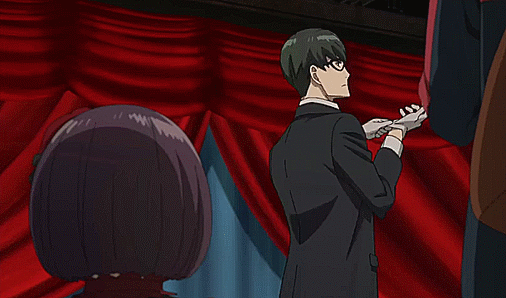
Babylon: NO, NOT FATE BABYLONIA! This is a mystery/thriller involving a case of illegal clinical research for a pharmaceutical company that leads down a rabbit hole full of murder, suicide, and political intrigue. IT’S LIKE DEATH NOTE AND MONSTER HAD A BABY AND IT’S FREAKING AMAZING! I haven’t been this interested in a mystery/crime anime since Erased. The first episode will definitely leave you...hanging…. The only problem is it’s not on Crunchyroll, so I have a feeling most people won’t know about it because it’s on freaking Amazon Prime!
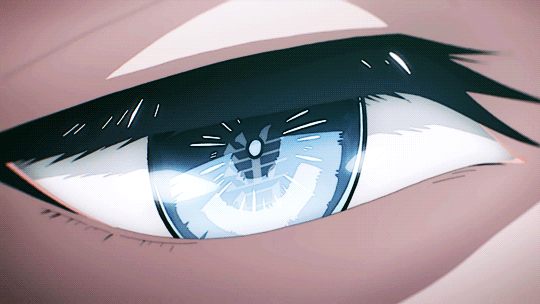
Hoshiai no Sora (Stars Align): A coming of age sports anime in which a boys soft tennis team sucks so bad that the school will disband them if they don’t win a tournament. And the team captain is so desperate for serious members, he literally pays his childhood friend who recently moved back into town to play on the team. And said childhood friend has an incredibly interesting backstory and struggling family life that ropes you in right away. How is soft tennis different from regular tennis? No clue, but this show is awesome! You can tell by the first episode it is going to be a great coming of age story, with more mature themes of abuse and class difference.
And it’s not the only sports anime with Sora in the title...
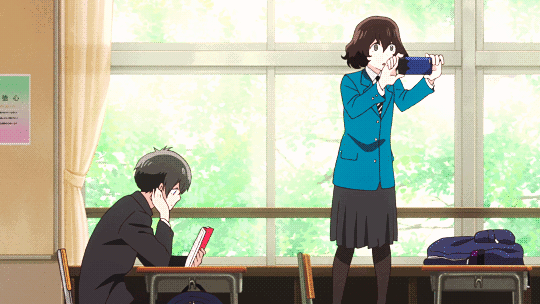
*Ahiru no Sora (Sora the Duck): Another sports anime, in which a short, spikey haired boy wants to play basketball (yeah yeah very original) but discovers that his high school basketball team is full of punks! It’s basically what would happen if Izuku Midoriya wanted to be a basketball player. The first few minutes are basically every sports anime you’ve ever seen, BUT it really lives up to its potential by the end of the first episode. It has a likable protagonist, good animation, and the female characters all wear realistic clothes to play basketball in! If you’re a piece of sports anime trash like me, this is definitely the show for you!

No Gun Life: In a detective noir world where everyone has basically become a cyborg, a guy with a gun for a head works to uncover the plans of an evil organization. That’s it, that’s the whole thing. It’s made by Madhouse AND IT’S A CYBORG WITH A GUN FOR A HEAD! What else do you need?!
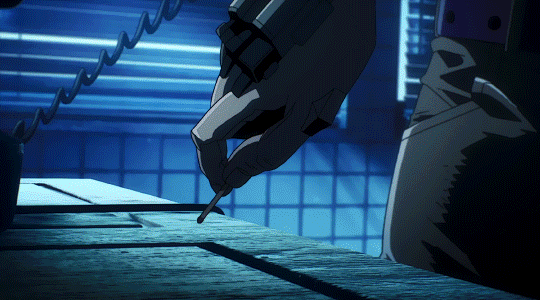
Beastars: IT’S JUST ANIME ZOOTOPIA! I’m not even kidding. It’s a school based mystery involving anthropomorphic animals who are faced with the murder of one of their classmates and the disruption of the peaceful coexistence of all types of animals in the school. It involves the whole predator vs prey dynamic and how appearances are deceiving, all with a jarringly serious tone considering everyone’s an animal. The only thing that doesn’t sit right with me is the use of 3D animation...which I notoriously despise no matter how great the show is. But even I am willing to put aside my hatred to keep watching this anime. The characters are interesting, it’s shot really creatively, and I love how ridiculously seriously it takes itself. Apparently it’s going to be on Netflix at some point.
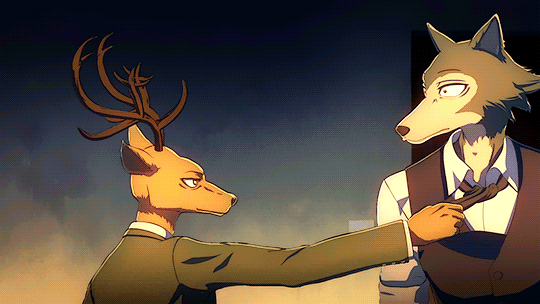
*Shin Chuuka Ichiban (True Cooking Master Boy): It’s Food Wars’ less porny sibling that takes place in 19th century China, where a young boy named Mao is a master chef who travels around spreading his love for cooking! This is a reboot/continuation of an anime based on a manga from the 90s so there’s a really fun retro art style that’s nice to see updated. Apparently it picks up in the middle of the original story, but I haven’t felt like it’s necessary to see the source material to enjoy it or understand it. Also the soundtrack is bomb! It’s a great shounen to watch if you want more cross-cultural cooking anime that’s not straight up porn in your life, and it will definitely make you hungry!
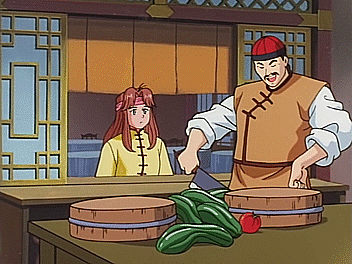
Next seasons and Continuations!
And don’t forget the summer leftovers, and some shows are getting continuations!
*Chihayafuru season 3: This is an incredibly fantastic underrated sports/club anime about a girl named Chihaya who struggles to find members for her karuta club after her best friend who made her fall in love with the game moves away. Never heard of “karuta”? It’s a physically and mentally challenging traditional Japanese game involving 100 poems written on cards that the players must memorize and locate before their opponent….it makes more sense when you see it I promise. This show is goddamn amazing, with incredibly realistic characters, an amazing game that most people don’t know about, gorgeous animation. It’s hilarious, it’s dramatic, it’s sad, and it’s uplifting all at once.
This doesn’t premier until October 23, (so you’ve got time to binge the first 2 seasons!) but this is by far my most anticipated show of the season and quite possibly the entire year! I’VE BEEN WAITING SO MANY YEARS FOR ANOTHER SEASON, AND I’M SO PSYCHED!
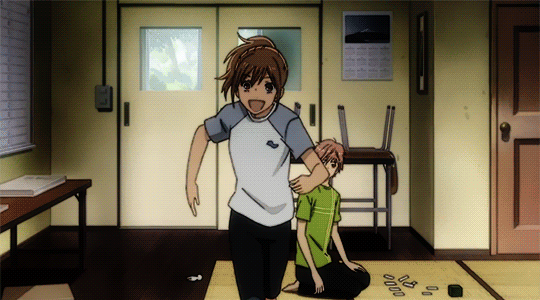
Kono Oto Tomare (Stop this Sound) season 2: Speaking of club related anime, in case you missed the first season earlier this year, this is an anime about a boy who tries to recruit members for his high school koto club after all his senpais graduate. What’s a koto club you ask? It’s a large Japanese string instrument that no one cares about or plays anymore of course! Their club is endearingly terrible, with literally only one competent person on the team, but they’re aiming for nationals anyway, because...of course they are. This show seems pretty textbook at first, but it really grows on you the further you get. There are great character dynamics, it’s fun, it’s sweet, and there’s cool music that people don’t hear a lot of! If you like sports or club focused anime, give this one a chance!
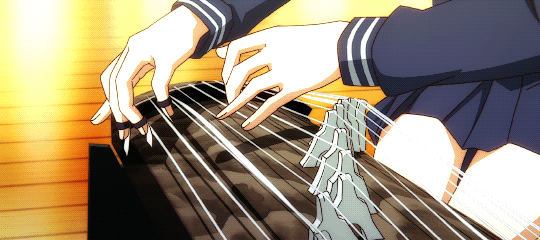
*Dr. Stone: An action adventure in which all of humanity is mysteriously turned to stone one day. When a genius high school boy named Senku and his….not so genius friend Taiju awaken 3,700 years in the future, the two must rebuild civilization and turn the world back to normal with the power of science! I know pretty much everyone is watching this already, but I just want to reiterate how amazing it is. It is mysterious, educational, hilarious, and it really makes you think about civilization as we know it today. It was one of the best (if not the best) new show of the summer, and I’m so glad it’s getting a full run!

Vinland Saga: THE VIKING ANIME IS GETTING A FULL RUN!!!!!!!! In case you missed this gem in the summer, it’s a historical drama about a young boy named Thorfinn and his journey to avenge his father’s death and become a great warrior. And it’s all while traveling with his enemies through Northern Europe. It’s a fantastic dark, realistic story in a historical setting that filled the void left by Dororo. Plus it’s animated by Wit, so it looks beautiful. The music is great, the characters are intriguing, the story is interesting, AND IT HAS AN AMAZING ANTAGONIST! It has hype written all over it, so I’m pumped for the rest of the season! Unfortunately, you can only find it legally on Amazon Prime, so that’s why no one’s watching it.

*Fire Force: The (unfortunately timed) action/drama where fire fighters with super powers must protect Tokyo from people who are spontaneously combusting and uncover the evil rooted within their own organization. It’s made by the same person who created Soul Eater, and it definitely shows. The animation is high flying and out of this world. It’s worth watching for the action alone. But be warned, the plot and characters are it’s biggest weakness. It will jump between gratuitous fanservice and hijinks and then rocket into moral dilemmas and disturbing situations with no warning. BUT I still like watching it for the action, and in these later episodes the plot has steered itself back on track a lot more, and I’m way more interested in where the story is going now. I’m hoping that means the second half will give us a better sense of the characters. It also has a top tier muscular waifu!
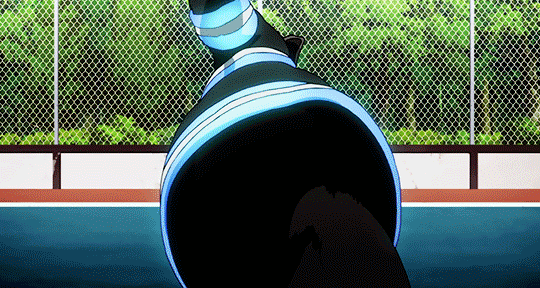
*My Hero Academia season 4: I’m sure everyone’s already going to be watching MHA, but I guess I’d have my anime fan badge revoked if I didn’t at least mention this one. I may not read the manga, but I know this arc is going to be a good one! I firmly believe this will be a modern classic, so if you haven’t checked it out yet, it’s really worth watching.

And that’s it for this season. I’ll probably do a list at the end of the year of my top shows of 2019, but otherwise, see you in the winter of 2020!
#long post#anime recommendations#fall 2019 anime#my hero academia#boku no hero academia#fire force#dr stone#vinland saga#Chihayafuru#kono oto tomare#stop this sound#shin chuuka ichiban!#beastars#true cooking master boy#no gun life#babylon#ahiru no sora#sora the duck#stars align#hoshiai no sora#kabukichō sherlock#chuubyou gekihatsu boy#UNEDITED BECAUSE THIS WEBSITES A BITCH AND DELETED MY FINAL DRAFT
46 notes
·
View notes
Text
OpheThorn II: A Slightly Less Rambling Analysis
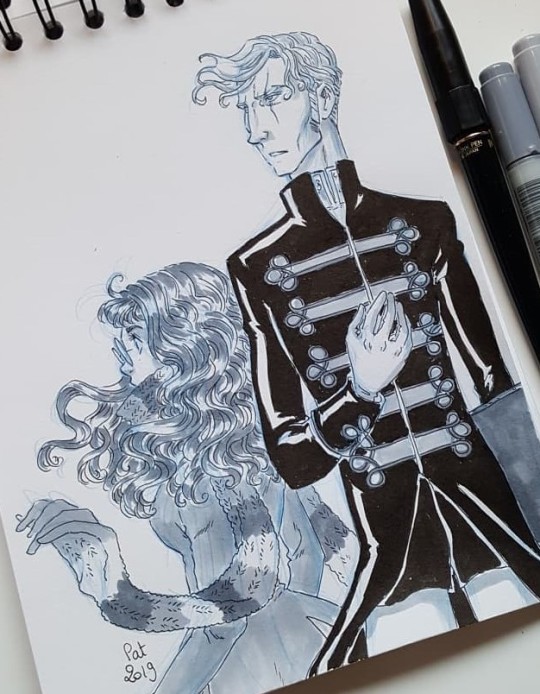
The Missing of Clairdelune is a superb second installment in The Mirror Visitor quartet. We get more of what we loved about the first book, more pieces to the larger existential puzzle, yet it smartly stops short of resolving too much so that we stay invested for the third episode. Christelle Dabos allows herself slightly more exposition. But the novel really succeeds by continuing to follow the less-is-more mantra and the showing vs. telling style.
As you may or may not recall, after I finished A Winter’s Promise, I spent an embarrassing amount of time copy/pasting excerpts from this book into Google Translate with the result that I really did spoil a lot of the OpheThorn parts for myself—which I don’t exactly regret. But, essentially, it left me with a bit less to say. I had a good response to my first OpheThorn analysis (it’s here and thank you for all the kind words), so I did think that I’d like to put something out about Clairdelune as well, I just wasn’t sure what. After some consideration (and a re-read), I do have some more thoughts about OpheThorn.
So, here we go.
[Spoilers included this time]
[All fanart images credited to @patricialyfoung]
Intro
Since Clairdelune begins right where Promise concluded, Ophelia is still pissed at Thorn, while Thorn is still pining for Ophelia albeit in his uniquely aloof way. The only real thing that’s made me scratch my head with them is the severity of Ophelia’s anger/resentment over Thorn having withheld his true ambitions from her and her finding out about them from someone else. I just think it’s a little bit of a weak conflict for them given how pragmatic they are. I get that it’s the culmination of a frustrating situation. But I still think it’s weak.
So, once again the two begin on shaky ground, a space they occupy for the bulk of the novel. They are, at least, together a bit more than before and there’s all sorts of lovely tension, mostly caused by Thorn’s inelegant method of wooing compounded by Ophelia’s stubborn refusal to give him an inch. Thorn’s growing feelings for Ophelia were subtly hinted at in Promise and they become more apparent here, particularly when juxtaposed against Ophelia’s stubborn denial of hers for him.
And I just adore the cover art! Don’t you?
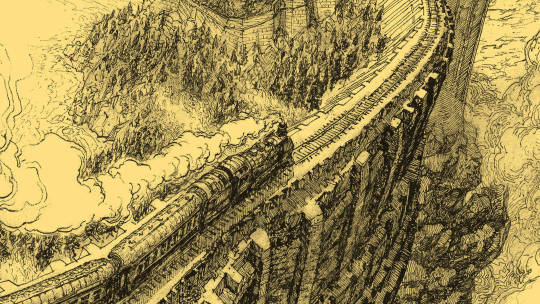
Thorn and Autism Spectrum Disorder
This is what I want to discuss. I may be alone in this, but it seems like Thorn could be coded as having autism spectrum disorder (ASD). It occurred to me while I was reading Promise and this time around, I feel comfortable in taking that perspective on Thorn. I like the notion of applying an ASD reading to his character because it explains a few descriptive quirks and makes him more than a “weirdo” or “freak”, which is reductive labeling. When considering his interactions with other characters and their reactions to him, this reading lends an added layer to his actions and overall development.
But let me make something clear.
This book isn’t about ASD, so I’m not suggesting that Dabos intended to write Thorn as having ASD or is trying to make a statement in any way on the disorder, and I’m cautious about how I use this idea to understand the character. This is purely my own speculation/take on the character.
I also want to be clear that I don’t have any personal experience with the disorder. I’ve met people with autism and ASD and they were all very different from each other and had very different needs. So, I’m largely making connections with textbook examples of ASD and they’re maybe a little bit broad because as I said it isn’t explicitly made clear that Thorn has ASD. I may very likely err in my understanding of this disorder. If that’s the case, I apologize in advance and please do correct me or give me your own opinion on this idea.
Here’s an overview from the webpage of the national institute of mental health:
Autism spectrum disorder (ASD) is a developmental disorder that affects communication and behavior. Although autism can be diagnosed at any age, it is said to be a “developmental disorder” because symptoms generally appear in the first two years of life. According to the Diagnostic and Statistical Manual of Mental Disorders (DSM-5), a guide created by the American Psychiatric Association used to diagnose mental disorders, people with ASD have:
Difficulty with communication and interaction with other people
Restricted interests and repetitive behaviors
Symptoms that hurt the person’s ability to function properly in school, work, and other areas of life
Autism is known as a “spectrum” disorder because there is wide variation in the type and severity of symptoms people experience. Although ASD can be a lifelong disorder, treatments and services can improve a person’s symptoms and ability to function.
It’s been shown repeatedly that it’s very difficult for Thorn to be an inviting and easy-going person, even with people he cares about. Thorn struggles with communication, is emotionally suppressed, is both uncaring and at times completely unaware of how he presents himself socially, and obsessively consults his pocket watch, particularly when he’s at a loss for words or bored, or otherwise ready to get the hell out of any situation that causes him anxiety. He’s highly intelligent, fixated on order and organization, and has a history (as we know from Promise and learn more about in Clairdelune) of meeting intense emotion with impulsive violence.
Here’s a list (also from the NIMH website) of common symptoms:
Making little or inconsistent eye contact
Tending not to look at or listen to people
Rarely sharing enjoyment of objects or activities by pointing or showing things to others
Failing to, or being slow to, respond to someone calling their name or to other verbal attempts to gain attention
Having difficulties with the back and forth of conversation
Often talking at length about a favorite subject without noticing that others are not interested or without giving others a chance to respond
Having facial expressions, movements, and gestures that do not match what is being said
Having an unusual tone of voice that may sound sing-song or flat and robot-like
Having trouble understanding another person’s point of view or being unable to predict or understand other people’s actions
Repeating certain behaviors or having unusual behaviors. For example, repeating words or phrases, a behavior called echolalia
Having a lasting intense interest in certain topics, such as numbers, details, or facts
Having overly focused interests, such as with moving objects or parts of objects
Getting upset by slight changes in a routine
Being more or less sensitive than other people to sensory input, such as light, noise, clothing, or temperature
People with ASD may also experience sleep problems and irritability. Although people with ASD experience many challenges, they may also have many strengths including:
Being able to learn things in detail and remember information for long periods of time
Being strong visual and auditory learners
Excelling in math, science, music, or art
One can’t help but notice that we can check several of these points off for Thorn. Not all, certainly, but I’m sure you can call to mind some of your own examples of him exhibiting many of these behaviors repeatedly.
Where Does Ophelia Fit In?
Thorn has always treated his relationship with Ophelia in a very business-like manner, almost like a negotiation, which makes sense within the context of an arranged marriage. At the novel’s start, Thorn wishes to make amends, but Ophelia makes it very clear that she will not forgive him for his lies and neglect. His response to her is rather clinical.
“We simply can’t allow ourselves to be enemies,” cut in Thorn. “You’re making my life difficult with your resentment; it’s imperative that we become reconciled. […] Meet me at the Treasury, insult me, slap me, smash a plate over my head if you feel like it, and then let’s never speak of it again. Name your day. This Thursday would suit me.” [65]
I suppose this is a rather annoying response, especially if one is really just looking for a simple and genuine apology. But if we read Thorn as having ASD, then this feels a little different. He’s simplifying a conflict that he maybe doesn’t quite understand; he’s been given a different perspective on his actions and it’s perhaps beyond his capability to comprehend. To compensate, he turns this into a matter of business, which is something he can understand quite well, even going so far as to try and pencil Ophelia into his calendar. But he’s woefully unaware of the frustrating effect his language and tone have on her. Of course, what’s key here is what he isn’t saying: that she’s making his life difficult because he loves her; he wants to be on good terms, but doesn’t know how to fix this. Note that he again suggests violence as a means to deal with her emotion.
When they do meet up, Thorn says,
“I have many enemies. I no longer want to count you among them, so tell me what I must do. That is why you came here, isn’t it? You have a deal to offer me, I’m listening to you.” [152]
He’s desperate. It’s also worth noting that he’s fairly vulnerable in this chapter; he exhibits jealousy and some hurt—Ophelia missed their original appointment because she was with Archibald and forgot about him.
Modest as always, Ophelia asks only for a job, money to pay Fox, her new assistant, and to see the real outdoors again. She lastly requests that he always be honest with her, especially in matters that directly concern her. In exchange, she will teach him how to Read objects after the ceremony of the Gift and he will teach her how to use the claws that he’ll pass to her. She also reiterates, for good measure, that this will be their only conjugal duty. He grants the first three readily enough, but the fourth one trips him up. He does agree to it, but it’s obvious that it will cost him in more ways than one.
While I imagine that he’s receptive on some level to sexual intimacy with Ophelia, I think he’s more afraid of intimacy in general. Sharing things and being honest with a partner means opening oneself up to vulnerability, to weakness. The undertaking he’s set for himself—a mission he’s already devoted 15 years of his life to—doesn’t allow for that kind of intimacy; rather, it requires utmost resiliency, secrecy, and focus. Furthermore, if he were to be seen forming loving attachments (with Berenilde, Ophelia, or anyone else), then that could be turned against him over the course of fulfilling his risky endeavor. It’s that very fear, in fact, which has made him exclude his aunt (and attempt to exclude Ophelia) entirely from his investigation. His pursuit of a noble title and legitimacy is a front, an easy excuse he thought up to satisfy Berenilde’s and the court’s curiosity about why he suddenly wanted to get married and Read Farouk’s Book.
Like Thorn, it scares Ophelia to feel herself falling in love. Perhaps the womanly pride she carries with her makes it difficult for her to open up. After all, love and marriage were never apparently high on her list of things to accomplish either. Ophelia and Thorn are separately dealing with the same conundrum, which is that to love means to fear, and that’s messy. It could get in the way of a life that is humble (Ophelia) and a life that is ambitious (Thorn). Simply put, neither one had accounted for even the possibility of love in their marriage.
Perhaps because Ophelia is a Reader, I think that deep down she likes the enigma and challenge that is Thorn. Yes, he’s frustrating, but she never truly loses interest in him. Indeed, if anything, she becomes increasingly intrigued and is entirely won over when she at last learns all about what he’s doing. Ophelia is very likely the first person to make Thorn both confront and attempt to correct his inadequacy in areas of intimacy. As I touched on in my previous analysis, Ophelia calling Thorn out on his behavior and habits is surely a novelty for him.
“I believe neither in luck nor in destiny,” he declared. “I trust only the science of probabilities. I have studied mathematical statistics, combinatorial analysis, mass function, and random variables, and they have never held any surprises for me. You don’t seem fully to grasp the destabilizing effect that someone like you can have on someone like me.” [377]
Ohhhhkay.
It turns out, she’s a bit of an enigma and definitely a challenge to him in kind. This is Thorn’s way of trying to tell Ophelia that he loves her.
Thorn and Ophelia seek control and wield it differently. Thorn can be arrogant and overconfident with it, and he wants to be its sole retainer. Ophelia also wants to retain it but as it pertains to her decisions for herself, and she rebels against it when she feels like that’s being taken away from her. It’s important to them that they are in control of their own actions and destinies. But what neither one of them understands is that those we end up loving is often (or maybe always) outside of our control. Love has no explanation, and doesn’t require one. You can’t predict it. You can’t dictate it. You can’t calculate it or quantify it.
Ophelia seriously turns Thorn’s life, and everything he thought he could predict or control about it, upside down. Initially unwittingly, then actively, she encourages him to develop.
ASD Made Sexy
As inelegant as he is, Thorn does have his own way of being shocking:
“You wanted me to be honest with you. You will thus learn that you are not just a pair of hands for me. And I don’t give a damn whether people find me suspect, as long as I am not so in your eyes. You will return this to me when I have kept all my promises,” he grumbled, holding his watch out to Ophelia without noticing her stunned expression. “And if you still doubt me in the future, just read it.” [156].
You guys, this is kind of romantic, right? He’s so direct and it really flusters Ophelia, who is steadfastly resisting the decidedly non-business-like turn their relationship has taken. Skip to novel’s end, however, and she has totally changed her tune about Thorn. Right before they believe they will be parted forever, Thorn finally gives a straightforward confirmation of his feelings.
“Don’t go falling down any more stairs, avoid sharp objects, and above all, above all, keep away from disreputable people, alright? […] Oh, and by the way, I love you.” [486]
Swoon.
The fact of the matter is this: despite his unconventional looks and mannerisms, Thorn hits a certain level of sexy. Which begs the question: Can ASD be sexy? Sure, one could say that his sex appeal comes naturally with his role as the male lead, which is directly connected to his chemistry with the female lead. But I think there’s actually an important distinction to be made; it’s not whether ASD itself is sexy, it’s whether a character with ASD is sexy and I think that’s important because you don’t want ASD to be treated as a gimmick in fiction. It matters how that kind of character is presented.
Thorn’s ASD traits make him eccentric at best and a “freak” at worst, by Ophelia’s own description. Some of Thorn’s less offensive eccentricities are portrayed in an endearing light: his brusqueness with silly persons (i.e. Archibald, Baron Melchior) and their silly behavior; wearing his heavy uniform in a tropical illusion when there’s no evident dress policy for officials; preoccupied with tending to the order of his office over the tending of his wounds; launching a dangerous existential investigation all because of an illegal and unjust disruption in odds and probabilities, an utter crime in Thorn’s eyes.
But it’s also important to look at how other characters view him. Those at the Pole may look down on him, but there is no doubt that he commands a considerable level of their respect. He’s at the center of Citaceleste’s political and economical arenas, and has some judicial power as well. In short, he’s the one that everyone seemingly runs to in a crisis. Ophelia begrudgingly admires his self-control, coolness under pressure, and appreciates that he is not corrupt, like the other officials and aristocrats. Naturally, Berenilde regards him the highest. She, more than any other, gives us a glimpse of the true Thorn, putting forward the image of a protector, provider, and all-around genius.
So, the answer is yes. Thorn is sexy.
Ophelia and Asexuality
OK, I realize I’m going off on a tangent here, but since asexuality is a common reading of Ophelia that I see in reviews, I wanted to address that as well.
There are many instances of Ophelia fulfilling, for lack of a better way to put it, the butterfly trope:
Perhaps it was due to the nervousness Thorn brought out in her, or the lace veil obscuring her vision, or the scarf coiled around her foot, or her pathological clumsiness, but the fact is, Ophelia tripped on the final step of the stairs. [28]
Hearing Thorn reawakened such nervousness in Ophelia that she seriously considered hanging up on him. [63]
She did, however, have to admit that Berenilde had got it right: it was indeed out of cowardice, more even than anger, that she’d spent recent weeks avoiding him. [100]
Somewhat embarrassed, Ophelia wondered whether he felt as nervous in her company as she felt in his. [160]
Ophelia felt her blood throbbing against her eardrums, but couldn’t have said whether it was due to sudden relief or, on the contrary, heightened tension. [323]
Ophelia gets butterflies whenever her love interest is near. It’s important to note that she’s not afraid for her safety when she’s with him, although there is one incident, where she thinks he’s going to strike her, which is quickly dispelled by his sincere assurance that he’d never harm her. He gives her butterflies often by doing totally mundane things such as standing in front of her or looking at her, and that bothers her. But why?
Like Thorn, she’s convinced herself that intimacy and love aren’t for her. Some reviewers have praised Ophelia for being a representation of asexuality and, while I think there’s a strong case for her being somewhere on the asexual spectrum, I stop short at positing that she’s totally uninterested in sex or doesn’t experience sexual attraction. She’s noted, on several occasions, both in Clairdelune and Promise, Archibald’s handsomeness. In this novel, she also notes Fox’s.
With his gold braiding and red mane, he was as dazzling as Thorn was dark. Ophelia sensed herself coloring just looking at him. [165]
So, she does experience sexual attraction and, furthermore, she physically reacts to Fox’s appearance (though never to Archibald’s), which suggests that she’s not wholly disinterested in sex. In Promise, she commented that “no man had ever quickened her pulse” and lamented about whether she’d ever feel that way about someone, and I think this is probably the point at which most readers took away that she might be asexual.
But, like...
Thorn is the only man who produces intense and consistent physical reactions in her.
Also, if you look at the [323] quote above, he did in fact get her pulse up. Just saying.
Rather than label her as purely asexual or even being on the spectrum, we could instead speculate that, as a Reader, she’s experienced to some degree love in all its forms through countless objects and perhaps she can’t help having this reaction to love and intimacy. I’m not trying to be cynical or pessimistic, but love can be treacherous and people are driven to do all kinds of terrible things for it or because of it. As wonderful as love is despite that, it seems likely that Ophelia has simply decided it’s not something she wants to navigate. Or she just hadn’t met someone yet who was worth all that trouble.
I’ll Close With This:
“You’re free,” whispered Ophelia. “Free to go, free to stay. I won’t make you leave one cage for another one, although, as you’ve seen, I really don’t live in great security. I decided your fate without taking time to think, or to speak to you. I was selfish…and I still am. […] I still am because, deep down, I would like you to choose to remain by my side. I know that apologizing can no longer change anything, but anyway: forgive me.” [135]
Ophelia says this to Fox after rescuing him from the dungeons of Clairdelune and taking him on as an assistant. Now, when I read this, I couldn’t help but think that it’s precisely the apology Ophelia wants to hear from Thorn. Yet, here she is, guilty of doing to someone the very thing she holds against him. Isn’t it funny how hypocrisy and love are such good friends? As we know, articulation and eloquence are not Thorn’s strengths and some of Ophelia’s aversion to him is based around her inability to accept this part of him.
Eventually, Thorn does make, more or less, the same apology.
“I should never have involved you in my affairs. I knew it would be dangerous. I convinced myself that I had the situation under control, and that mistake almost cost you your life. […] There is one thing that I have tried to tell you several times. I’m no good at these formalities, so let’s get on with it and speak no more of it. […] Please forgive me.” [444-45]
Strangely, she barely acknowledges this; she’s too busy having an epiphany.
At that second, she finally knew with absolute certainty where her place was. It wasn’t in the Pole, it wasn’t on Anima. It was precisely where she was now. At Thorn’s side. [445]
Well, perhaps this isn’t so strange since the novel starts off posing the question to this answer.
Deep down, Ophelia wondered where exactly her first home might be. Since she’d arrived at the Pole, she’d already visited Berenilde’s manor, the Clairdelune embassy, and her fiancés Treasury, and she hadn’t felt at home in any of them. [24]
The theme of home and belonging permeates this novel in a more central way than its predecessor. Ophelia is repeatedly confronted by it, but it’s also echoed in Farouk’s obsession with the Reading of his Book and finding out where he comes from and what happened in his past. When her family arrives from Anima, she sees the Pole and Thorn through their eyes. She ends up defending both from their disapproving remarks and in doing so, she realizes that she has ceased thinking of Anima as her home.
Life in the Pole was like that: wherever one went, whatever one did, danger was part of daily life. And yet, Ophelia reflected, she didn’t hate it that much, that life. [280]
Thorn’s apology seals the deal: she understands now that she was mistaken. Home is not a place. People, those who love you and who you love in return, give a home meaning. Belonging, likewise, is only made possible by the people who accept you and give you a place among them. It’s been hard-won, but she’s found both in the Pole, in Thorn and Berenilde. Her lack of a direct response to Thorn’s words suggests that she’s already forgiven him, that it matters less to her that he struggles with communication, that she’s finally accepted him for who he is and, better still, found him lovable despite that.
If we read Thorn as having ASD, then this intense dynamic between them is a positive treatment of mental/social disorders in fiction, which is really the only point I had to make with this entire thing.
Where Does Ophelia End?
I asked this question in my last analysis. Based off of the fact that, when we left her in Promise, she was experiencing some serious discomfort in body and soul directly connected to Thorn, I predicted/semi-already-knew that she would evolve toward him.
At one point, Ophelia loses the ability to pass through mirrors. We understand that it’s because she’s been lying to herself; after all, her great-uncle made it very clear that mirror-traveling is impossible under such a circumstance. It’s ironic because, by her own admission, she’s a “bad actress” [161] and, according to her mother, “was never any good at lying” [157].
She’s just so stubborn, isn’t she? It’s gratifying then to read when Ophelia overcomes it. Thorn makes a public announcement, cancelling his marriage, refusing to Read Farouk’s Book, and handing in his resignation as Treasurer. He does this to protect Ophelia and her family from imminent danger but at risk to his own welfare and position. He’s basically committing suicide, which very nearly turns literal at novel’s end. Ophelia can only think to go to him by the quickest means possible.
She looked straight at her determined face, beyond its scratches and bruises, finally ready to face that truth that she hadn’t wanted to see. It wasn’t Thorn who needed her. It was she who needed Thorn. Ophelia plunged, body and soul, into the mirror. [416]
I don’t think I need to spell that out.
Thorn and His Watch
To go on a little bit of a tangent, I also wanted to touch on the watch.
I believe it was mentioned in Promise that the watch had been a gift from Berenilde, which is so precious. Berenilde is the only true parental figure Thorn has known. She used her status and wealth to protect and care for him, and seems to understand him as only a mother--one with a child the rest of the world refuses to accept--can. I thought her reaction to Thorn’s suicidal announcement was especially devastating.
She had begun to shake so hard that Agatha rushed to take the baby from her arms. Bent double in her chair, as though punched in the stomach, Berenilde looked imploringly at Ophelia. “I beg you. Don’t abandon my boy.” [412]
Keep in mind that Berenilde has outlived her three biological children, none of whom survived past childhood. Thorn is such a lonely figure that it’s easy to forget he comes from somewhere. But Berenilde’s reminder to us is clear: he’s not the child of his Dragon father nor of his Chronicler mother. Thorn is her child, and she’s terrified of losing him like the others.
While there can be no doubt of her sentiment toward Thorn, it’s entirely likely that Berenilde foisted much of her maternal grief, trauma, and longing onto him without his express permission; he never seems to regard her with any particular filial warmth. Then again, he once attacked Archibald in defense of Berenilde’s honor, after he seduced her away from Farouk, and Ophelia later notes that he “suspended an investigation and jumped into an airship” to be near to Berenilde when she went into labor with her daughter [373]. Thorn is clearly defined rather more by his actions than his words. But the point is Berenilde is the one who gave Thorn his sense of belonging, and I just adore that.
Metaphorically speaking, the watch represents Thorn’s heart, which was given to him by his mother figure and which he gives to Ophelia as a token of his love and trustworthiness. Indeed, it’s even called a “mechanical heart” [156]. Ophelia has Read one of Thorn’s possessions before (dice) and was overwhelmed by the fury and breadth of his emotions. If she were to Read his watch, she’d probably die. Every time he digs it out of his pocket to look at it, to hold it, to fiddle with it, he’s engraving some emotional signature or trace onto it. Ophelia ultimately decides not to Read it.
“Before you go, I would like to return this to you. You need it more than me, and, in any case, I won’t read it. I’ve chosen to trust you—you, not your watch.” [285]
Her words have a profound effect on Thorn, rendering him totally speechless and maybe more confused than ever. At any rate, he misreads the situation and catches Ophelia off guard with an awkward kiss. It’s kind of a heartbreaking scene, because Ophelia simply reacts (by slapping him) and is genuinely baffled that he took her words for encouragement. I don’t necessarily take this to be evidence of her asexuality. I don’t discredit it by any means, but it just feels more like she was taken by surprise.
The thing is, for perhaps the first time ever in his life, he actively desired for someone to know his true heart and to trust in his sincerity, which is why he gave the watch to her in the first place. In his defense, this was quite a pretty and irresistible thing for Ophelia to tell him and I don’t think she’s as put off as she wants to be.
With ears burning and glasses crimson, Ophelia stared at the faded letters on the old wooden panel—“STAFF ONLY”—as if Thorn might, at any moment, retrace his steps, take back his kiss, and leave his fob watch with her, as she’d suggested in the first place. [286]
It’s funny. She wants to erase the uncomfortable physical side of the incident, but she also wants to retain his metaphorical heart. I mean, yes, it’s broken because of some careless action on her part and she asked for it back so her great-uncle could try to fix it. But still. It’s hard to ignore the metaphor there as well: if the heart watch has changed from beating to broken and she wants to hold onto the broken heart watch to try to mend it…
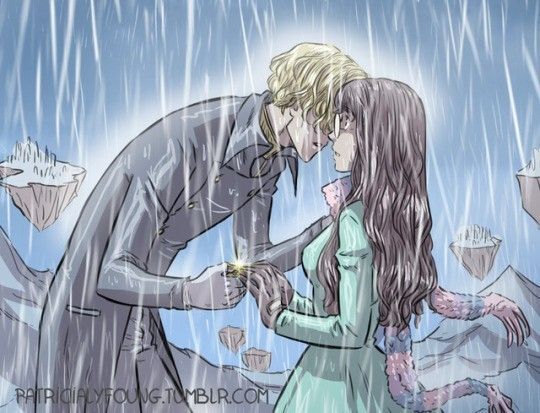
Well, good Lord, it’s just so obvious, isn’t it?
End
Well, that’s about it. As I said, I really only had the one main thought and then a bunch of smaller ones.
I just learned—and am seriously devastated—that The Memory of Babel won’t be released in the U.S. until May 2020. I’m hoping this is a tentative date and that it will be available sooner.
In the meantime, if someone could upload a PDF that I could then spend days plugging in to Google Translate (again), that’d be super greeeeaaaat…
For part III, head here.
#ophethorn#La Passe-Miroir#les disparus de clairdelune#the mirror visitor#the missing of clairdelune#christelle dabos#long book report
159 notes
·
View notes
Text
yalright let’s do this
AGENTS OF SHIELD SEASON ONE REWATCH COMPLETE BREAKDOWN MEGAPOST
hella spoilers for the entire canon up through season 5, but not 6 because I only saw it the once and am having a hard time remembering ANYthing about it.
I cannot determine specifically what it was about this season that caused to be branded “literal garbage” in my mind-hole for seven years.
Best guesses:
there’s some cheesy stuff that probably didn’t sit well with me at the time, and, at the time, there was no way of knowing that that kind of stuff was going to be ultimately eradicated
there’s some good stuff, like character stuff and plot stuff, but it didn’t successfully implant positive emotional responses in my brain-hole, leading me to be frustrated/offended at its own self-importance
there’s some stuff that just Doesn’t Work. I won’t call anybody out, but there are some main side characters whose casting, in my opinion, leaves much to be desired. when it comes to acting ability, I feel that it’s important to have the ranges of your entire cast match each other. if you’re gonna hire B-listers, at least make sure they’re ALL B-listers. if you’re gonna splurge and get some S-tier talent, pleeeeease don’t embarrass the B-listers by thinking you’re doing them a favor by including them on your project. Understood, this opinion is highly subjective and I can’t expect everyone in front or behind the screen to buy into it, but it’s definitely a pet peeve of mine that causes strong reactions in me*
some of the plots are tired and/or straight up boring. I got through them easily this time through because I was able to focus on the things I like, which is largely character interactions and re-learning the backstory for stuff that I know will continue to be important later on. imagine listening to your grandpa’s stories about his life, but instead of telling you the cool stories about going to the moon or whatever, he’s telling you in great detail about the time he got his shoelaces stuck on like, a rusty nail sticking out of a fence. It’s not a great story but it does explain why his mom only bought him velcro shoes after that and one time when they were trying on shoes in the store a couple of years later, some other kid started making fun of him for having velcro shoes and long story short your grandpa’s relationship with that kid is what got him interested in astrophysics and also he married that kid twenty-five years later -- but right now the story is specifically about spending forty minutes trying not to get tetanus.
Now that I’m older and wiser, what really surprised me throughout, though, was that not only was I not having any type of reaction that validated my “literal garbage” classification, I was noticing that there was A Lot of stuff that ticked a lot of boxes.
I’m talking technical stuff, the textbook basic filmmaking stuff, the stuff that I subjectively find objectively “Good” because it means that creative decisions were made with intent and were also executed proficiently enough to make that intent clear.
I’m talking SYMMETRICAL NARRATIVE which has to be one of my all-time favorite techniques, one that I personally use a lot, and I’m very biased in responding favorably when I see it, so I think ultimately this is a huge reason why this season cannot be classified as garbage this time around. Because it shows that they cared! It shows that they had A Plan! It’s an emotionally satisfying technique that can be used to great effect when tipping the audience off to how far we’ve come from where we started. It creates this nice tidy structural loop which I find very appealing.
Just real quick, you see this in individual episodes or even scenes, too. Here’s a classic A+ example from episode 2:
Simmons has given Skye a bottle of water as a gag because that’s what happens on planes, and that bit is a set up to this bit, where Coulson is talking about how he rebuilt the Bus from the “studs up” and it demands to be treated with kid gloves; ergo:
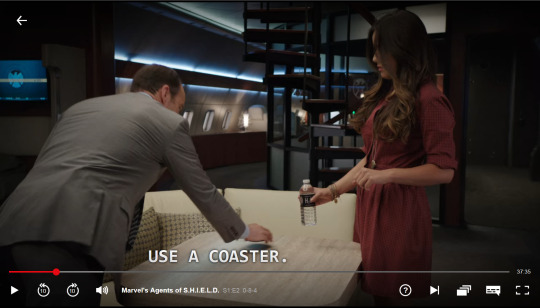
Only to have the thing completely wrecked over the course of the episode. In the denouement, “just starting to warm up to this place,” Coulson says ruefully, righting a broken glass as if that will put the plane back together; Skye immediately tosses a coaster down and moves the glass on top of it.

As a callback, it juxtaposes the starting-state and ending-state in your mind and highlights the contrast between the two. And it’s also a nice character-building beat where you, the audience, get to observe Skye’s character in that she remembers a trivial detail that happened to be important to Coulson. You also get to see Coulson observing the same, and you understand a little bit more about both of them. *chef’s kiss*
So this is a pretty powerful and common technique, and I guess you could say that any well-resolved narrative is by definition going to recall you to the specifics of how it started. Like ep 1 we start with Mike and Ace, their call and response “what are we/we’re a team,” and an understanding of Mike’s desire to be his kid’s guardian and hero and his desperate search for the tools that will allow him to become that. In the finale, we see the pay off where Ace (via Skye) reminds Mike of this motivation, and Mike is finally in the position to protect his kid by taking out the Big Bad.
But I don’t want to go through the list to demonstrate that everyone’s character arcs likewise left them in a thematically resolved position relative to where they started. Obviously this is an expectation of all (well structured) narratives.
(And I don’t really mean to talk about callbacks themselves, such as Fitz’s obsession with monkeys or May’s repeated demand of “don’t call me that.”)
Stuff that only comes up at the beginning and the end. Here’s the kind of symmetry that I mean:
Skye’s use of GPS encryption and the location of the diner where she first meets Mike. Both topics come up in ep 1, and are revisited in ep 20 when she’s stalling for time against Ward and brings him to the diner by telling him that it’s the GPS coordinates necessary for decrypting the drive. It says, last time you were here, Skye, you were living out of a van and fangirling over people with superpowers; now you’re an official agent of SHIELD (fun while it lasted, anyway) and you’re currently doublecrossing your own doublecrosser who was directly responsible for transforming you into the competent spy you are today.
Same thing: the only time we see Lola fly is at the end of ep 1, when Coulson and Skye are heading back to the Bus, and in ep 20 when Coulson rescues Skye from off the Bus.
Ep 2: 0-8-4. We’re introduced to the very first object with the titular designation, and Simmons idly wonders “imagine what it would do to a person.” Ep 22, it’s used to evaporate Garrett. Same ep, we also meet the little, what even is it, that dendrotoxin EMP (??? I don’t recall whether the gadget is named) that Ward uses, and Coulson uses it in ep 17 to incapacitate Garrett.
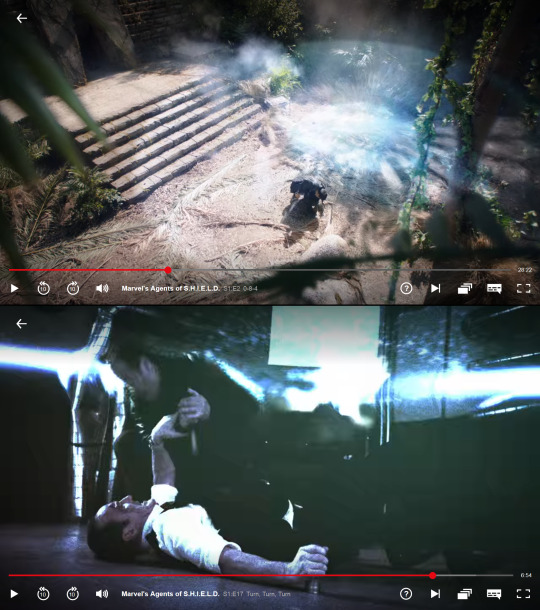
Similarly, all the cool alien gadgets we spent the first few episodes gathering and locking up, including that first 0-8-4, are all broken out into the wrong hands in ep 18.
Also in ep 2 we are introduced to the idea of being thrown out of the airplane and Skye & co specifically prevent Ward from being sucked out. We’re introduced to the concept of Coulson’s cellist! Fury also makes a cameo (”talkin to me about authority”) !
It’s a little later on, but ep 6 has Simmons jumping out the plane, and Ward proving his Good Teammate status by jumping out after her (while Fitz is struggling on his way to do the same). Ep 21, Ward boots FitzSimmons out the plane, and in ep 22 Fitz finally has the chance to properly save Simmons himself.
Ep 19 Coulson has a chance to save his cellist (again)
Ep 22, Fury comes back all Deus ex Machina and relinquishes authority of SHIELD directly to Coulson.
There’s also some dialogue recycled on purpose to make a point, like Fitz-Simmons introductory scene is recreated almost verbatim in ep 21:
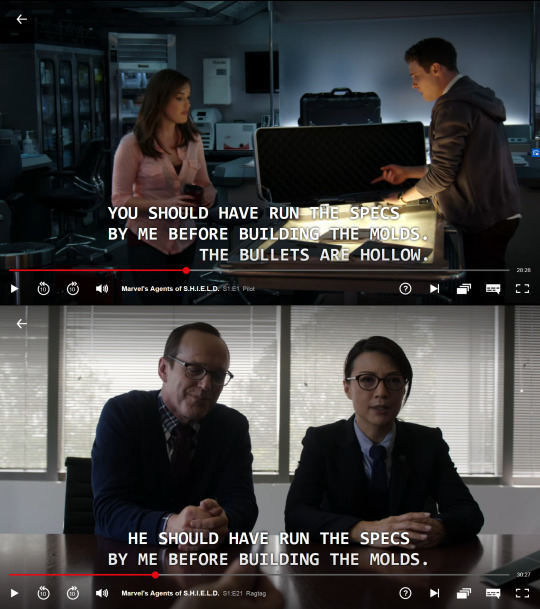
Ep 2, talking to Skye about his mission vs ep 18 talking to Raina about his mission
(gotta admit, the man took this role seriously. check out that cheekbone game he achieved in such a short time)
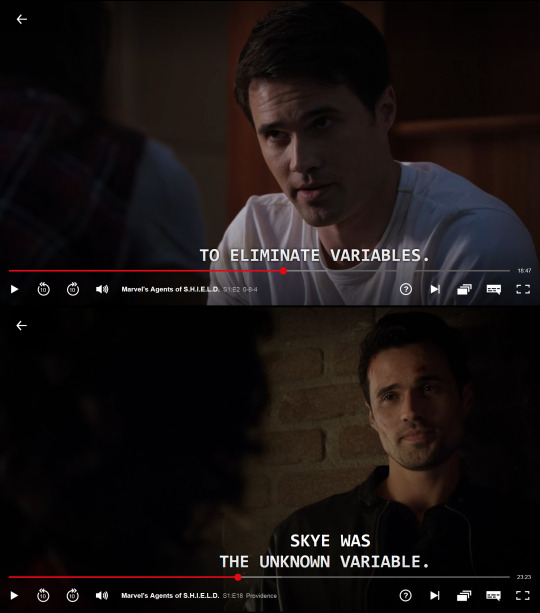
And again, Ep 1 Ward vs Ep 18 Ward. They even framed it the same!!

All this to say, Season 1 is Structurally Sound and it has my blessing.
Now let’s move on to the list of things I liked that surprised me:
It’s pretty well polished, visually. Joss Whedon’s veteran control of the director’s chair is readily apparent in the pilot, setting the visual tone for the series. There are some made-for-tv shots over the course of the season, sure, and the least impressive compositions tend to involve CGI backdrops, but they do make the most of their interior sets and work hard to dress up various LA locations to, er, inspire the idea of the international scope of the show. In my last update, I talked about ep 8 The Well in the context of Quality Directing, so it definitely goes above and beyond the basic shot-reverse shot when it wants to.
Ward. Just for the record, I think Brett Dalton is great at his job and really brought exactly what they wanted to this character. Eps 1 and 2 are a little shaky and stiff, but everyone’s performances are, as they let these characters coalesce around them. I remember not liking Ward when I was watching this live, and honestly I think this was intentional. He’s that character that you expect that you’re expected to like, you know, the traditional cocky savior type that lots of those fancy heroes are. But because he’s so tropey in his characterization, you’re just ... over it? And then when they flip the script and you’re supposed to hate him -- WOW. It’s like two Christmases at once. They took something you were already doing and rewarded you for it.
I’m not unaware of the “redeem grant ward” phenomenon. I’m aware that the character had fans who were honestly drawn to and appreciative of the character before that persona was revealed to be a lie.
And honestly, it’s not that I like OR dislike Ward at all. As a person. It’s annoying that he’s a cocky bad-boy. But it’s sweet when he plays nice with Simmons. It’s embarrassing that he and May have “a thing.” But it’s cathartic when he opens up to Skye about his past. And Then, the sequence where we know he’s Hydra but Skye doesn’t. And Then, the sequence where Skye knows he’s Hydra but he doesn’t. And Then, his weird yucky confusion where he still wants to pursue something with Skye or doesn’t want to put down puppy-dog-eyed Fitz.
As a character, Ward is a great character. His set up is so bland that the twist does appear to come out of nowhere, but on a rewatch all the groundwork is there. His characterization as a baddie is enthralling. I’m forecasting into season 2 a bit, but you want to follow his nefarious exploits just as much as you want to see his ex-friends smash his face in. Brett Dalton played it right, A+ good job. It makes Framework!Ward just that much more of a beautiful thing, to get to see what it would have been like if the Season 1 persona had actually been the man.
Also as covered in the last update, I was really very pleased to see how much character work was being done in this season. Because I only watch and rewatch starting from the second season, there are important plot points that I’d been grudgingly attributing to this season about which I’d forgotten the specifics, such as, what’s the deal with Gravitonium, howcome we hate Ward so much, where did they get that memory-torture-machine, why are you acting like I recognize Titus Welliver’s character? What surprised me was how much of a focus there is on character development as well. A lot of good origin story stuff, like how green FitzSimmons is and how soft and good-hearted Skye is and all the reasons we respect and trust May and all the reasons we would follow Coulson to the ends of the earth. Watching a found family start to put down roots is worth it, too, ten times out of ten.
The tie-in stuff wasn’t as overstated and stifling as I remembered it being. They were allowed quite a long leash even this far back. Centipede is based on Extremis, but helms a a unique narrative. The Asgardians-of-the-week are just MacGuffins for driving character stories. Turns out all of SHIELD has been Hydra all along! Sucks to be you, a show about the Agents of SHIELD ... oh wait, Daddy MCU’s insane twist is mirrored in the DNA of your team’s composition AND baked into your overall season arc? Well then. Carry on!
Engaging with Season 1 explicitly as a prequel is a powerful thing. First time through, I had the distinct realization that “too much of a good thing” was at play regarding Coulson. He’s everybody’s favorite MCU character in 2013, hands down, but ... getting intimate with him for 40 minutes a week really waters down his mysterious G-man appeal. BUT. After spending six+ years with the man, Season 1!Coulson is a precursor to the 3-dimensional Director you’ll fall in love with, rather than a distortion of the one-liner MCU!Coulson you thought you wanted.
So what’s next! Absence makes the heart grow fonder, and here all all the things I associate with AoS that were not present in Season 1:
Robot hand.
DaISy JoHnsOn
AGENT/DIRECTOR MACK where is he I need him
Fitz’s facial hair
Their underground SSR base with the exposed brick, I miss that place all the time
Hive, Bobbi*, Hunter, Kyle MacLachlan, Maveth (everything** about Seasons 2 and 3, really). Robbie Reyes. Aida and Kasius!! I know these things are temporary, but they’re so important to the best bits and I love them.
Getting to see episode after episode where there are scenes at a time containing a majority (up to 100%) of women and/or POC characters with executive agency, and none of those characters are token or temporary but were placed there with intent to normalize a diversified cast.
My absolute favorite episode of all time, 4x15 Self Control.
Things I am not looking forward to:
**Lincoln. I’ve seen these seasons four times and just now I had to google his name because I wasn’t sure it wasn’t Logan. He’s garbage and I’m glad he’s dead. Other opinions are available.
Misc. Thoughts
*I said I wouldn’t name names but Adrianne Palicki is a C-lister who can swing a B+ if the stars align. I love Bobbi, though, especially the way the character’s reputation precedes her, how her adorableness complements her badassness. In fact, the character’s a great foil to May, who is also a badass lady and S-tier agent but has a completely different approach to being those things. Bobbi’s a reminder that badassness and aloofness are not correlated at all. Also there’s a headcanon out there that she’s non-binary (one of the reasons she prefers Bobbi over Barbara) and that is a concept I can get behind. Bobbi’s perfect and I’ll fight you if you don’t agree.
Poor Trip!!!!!!! When you always start from Season 2, he’s really just a flash in the pan, there and gone. I’ve always been like, “well, he didn’t really have a home here, no carved-out niche, so I guess getting Coulson’d and becoming something to avenge is the best a character like him is gonna get.” But now that I see that he comes late to the game as a literal stand in for Ward, his story is that much sadder. He was never intended to BE a character. He’s introduced with Garrett as a pawn/distraction during this arc’s who-is-Hydra shell game, he’s kept to demonstrate what kind of friend and agent Ward should have been, his defining character trait as a gentle flirt only serves as a catalyst for Fitz’s coming to terms with his feelings for Simmons. The poor guy is just a walking plot point, up until the bitter end. :<
I had entirely forgotten and/or never tracked the fact that Fury put together Coulson’s team specifically to monitor him after project T.A.H.I.T.I. I’d forgotten the distrust Coulson has for May after he perceives that she has betrayed him by being a part of this. It’s a season-specific reveal that is literally never mentioned again. It’s important to the fabric of the narrative of that particular arc, offering up May alongside Ward and Trip as fodder for the aforementioned shell game, but the true inciting incident of this entire show just gets swept under the rug and ceases to matter. I’m kind of :/ about that.
When you’re bi and non-binary, you’ll get a lot of mileage out of wanting to be/be with Daisy and/or Fitz, don’t judge me
In conclusion, Season 1 is the opposite of literal garbage, Agents of S.H.I.E.L.D. is my favorite show and my favorite MCU movie, Daisy Johnson is my favorite Marvel superhero (not related to Season 1 but still true), and nobody had better spoil Season 7 for me pleaAAASE don’t let it happen.
2 notes
·
View notes
Text
Por vs. Para... una pesadilla de mi existencia
(A/N: For some reason on the dashboard my bulleted points are showing up as on the same indent but on my actual blog page each one is indented accordingly (if that makes sense)??? So if you’re confused about which bullet point belongs under which bullet point, just view the post on my page. Sorry for this inconvenience!)
Hola a todos; today’s post is dedicated to yet another bane of my existence... por vs. para.
For the longest time I’ve struggled with understanding the difference between these two prepositions, so much to where I’d get points deducted off of my tests and essays I had to turn in for COLLEGE Spanish classes 🤦🏾♀️ BUT NOW THERE’S HOPE! Thanks to this Spanish class I’m taking in Madrid, my seemingly eternal confusion of these prepositions has been vanquished, and I now have a clearer understanding of how to use them! However, a new challenge has arrived: being able to remember all of the differences in usage, especially the more minute ones 😬😬😬
So, to face this challenge head-on I’m making a review post to fortify my understanding of por and para. Now, without further ado, ¡¡¡TIEMPO PARA REVISAR!!!
POR
Can be used to express the following:
Location of performed action
Ex. “He dado un paseo por el Retiro.”
(1)Time of event / time of day
Ex. “Vendremos por la Navidad.”
Ex. “Normalmente corro por las mañana.”
Cause
Ex. “Nos fuimos de la playa por el viento.”
Distribution
Ex. “He repartido 2 galletas por niño.”
(2)Manner / method in which something is done
Ex. “Hablamos por correo.”
Transaction / exchange
Ex. “Lo compramos por 20 euros.”
Ex. “Te cambio mi móvil por el tuyo.”
(3)Motivation
Ex. “Ha dejado la carrera por su novia.”
= “En lugar de”
Ex. “Haz esto tú por mí.”
Gratitude
Ex. “Gracias por el regalo.”
(2)= “A través de”
Ex. “Vi a mi amigo por la ventana del coche.”
(4)Opinion
Ex. “Por mí, haz lo que quieras.” (no me importa)
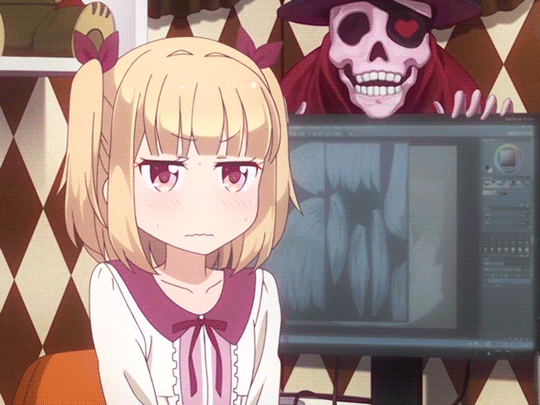
... Now you see what I mean when I say there’s a new challenge to face? And it doesn’t help that, again, there are these small differences in usage, like for the “= a través de” and “manner / method” bullets... Speaking of which, I'm sure you’ve noticed the number next to some of the bullet points. Well, in relation to the minute differences I mentioned earlier, I'm noting some that I believe need to be explained in depth (both to all of you and myself); these note will be under the “Keep Reading” section, so feel free to access them if you can’t wrap your head around some of these uses!
Onto the next one!
PARA
(3)Intention / purpose
Ex. “Vamos a Madrid para visitar a Juan.”
Designation
Ex. “no es una película para niños.”
Destination
Ex. “Vamos para casa.”
(1)Deadline
Ex. “La publicación es para abril.”
(4)Opinion / petition
Ex. “Para mí, la mexicana.”
(In spite of an) Obstacle
Ex. “Para haber llegado a las 4 de la mañana, está muy despierto.”
Ex. “Para ser una economía muy grande, los Estados Unidos tiene mucha pobreza en sus grandes ciudades.”

So, who else is feeling this mixture of surprise and overall sense of betrayal that this GIF expresses due to 1) having used textbooks in school that had WAY more to say about para than por, and 2) didn’t explain their differences as in depth as this post? ... Come on y’all; don’t tell me I’m by myself! I can’t be the only one!
Alright alright, guess it’s a party for 1 over here 😭😭😭 SIGH
That’s okay, because at least I NOW have better knowledge of how por and para work in tandem!
As I mentioned above, the numbers in bold that I put next to certain bullet points further explain the exact difference between said bullet points that may draw some confusion for you guys and certainly draws confusion for me lol. These notes are organized under the “Keep Reading” tab if you need them; hopefully they’ll clear up any confusion anyone may have!
Thanks in advance for reading, and I hope this post helps those currently struggling with sorting when to use por and para!
¡Salud! 🥂
Apuntes (trans. “Notes”)
#1: Time of event / time of day and Deadline
These two points didn’t give me a hard time, but just in case:
When I say time of event / day for por, I mean that por is used in this case to express when an action is done or will be done. For example,
A: “When will you come over?”
B: “Vendremos por la Navidad” (Trans. “We’ll come over for Christmas.”)
When I say deadline for para, this means that para is used to express when something is due, like an assignment or the completion of an action in general.
A: “When do we have to publish this article?”
B: “La publicación es para abril.” (Trans. “The publication is due in April.”)
#2: Manner / method and “a través de”
Taking the example sentence from above, “Hablamos por correo” (Trans. “We talked by email”). The question that comes up in my head is “HOW did we talk?”, the answer being “by email”. By this association, I think of using por in statements that answer the question “how”.
For the manner / method bullet point, I’d translate por to “by, through, via”.
For “a través de”, I’d only translate it to “through”, since that’s what “a través de” also translates to.
#3: Motivation and Intention / purpose
From my understanding (given the example sentences above the cut):
Por is used to express motivation for a completed action that the subject DID NOT intend to perform beforehand, or from the get-go.
Para is used to express intention / purpose for an action – in other words, something that the subject PLANNED to do AHEAD OF TIME.
#4: Opinion and... Opinion (/ petition)
For this one, the difference is a matter of whether you actually have an opinion or not
Regarding por, in my notes I have in parentheses next to the example sentence “(no me importa)”. Meaning that one uses por to express an opinion that in itself expresses apathy or indifference. Or rather, you use por to show that you don’t actually have an opinion of whatever is happening in a given situation.
As far as para is concerned, it’s the opposite; you DO use it to express an actual opinion (or preference, hence the “petition”).
#Spanish#Español#Grammar#Gramática#Black Linguist#NOLA in the house#⚜️⚜️⚜️#Langblr#Studyblr#Original Post
2 notes
·
View notes
Note
Since (from what I've seen) this is a pretty popular opinion, do you think rwby had a drop in quality after volume 3?
No. The exact opposite actually. I tried to watch RWBY Volumes 1 and 2: I can’t. I can’t stand those seasons anymore.
They have the worst animation (’But fight scenes!’ Fight scenes do not make up for the numerous non fight scenes with animation issues that an AMATUER could fix.).
The worst writing (Yes Badge and the Burden, tell me all about how Weiss is a spoiled princess while in the same Volume and throughout the rest of the fucking show reinforce the idea that Weiss is NOWHERE NEAR that. I’ll sit you next to those cringey anime clichés that infested Volume 1, The sheer amount of nothing in your episodes *cough* Food Fight episode *cough*, the rivalry Blake had with Torchwhick which was based on ‘the orgnazation blowing up traincars of innocent people is obviously being controlled by this one human!’, the stupidity of Weiss’ crush on Neptune, Neptune in general, Raven showing up in a dream despite her character being reliant on DITCHING Yang and that Volume 2 finale that CRUSHED the threat of the Grimm which Volumes 3, 4 and 6 had to rebuild and those WF members who still listened to Torchwick despite him being openly racist to them.)
The worst characters (Neptune is only not a Mary Sue because a lack of screentime. He’d be a textbook example otherwise. Mercury has no depth to him. Emerald’s unhealthy attachment to Cinder isn’t even hinted at here. For someone who wants to loom after Ruby, Yang DITCHING her on her first day is fucking inconsistent. Ren and Nora are one dimensional. Glynda...what exactly did she add again? You could have replaced her with Ironwood or Qrow and we’d get more out of her scenes due to her never having a personal connection to anyone and never giving a reason why she’s loyal to Ozpin. And Torchwick? Oh boy, wait til I get to Volume 3)
Really, the only reason people watch Volumes 1 and 2 is because you NEED to. If they were properly remade, they’d be obsolete.
And really....was Volume 3 even that good in the first place? It had the Maidens (worst writing decision of all of RWBY), Weiss demanding Neptune being beaten for being a flirter (reverse the genders and see how cringey that moment is), nothing still with Nora and Ren, Ruby doesn’t get nearly as much development as she should. Torchwick’s reason for fighting sounds good on the surface until you take into account how jovial and joking his character normally is and how he’ll taunt Cinder’s associates or even joke with Cinder himself despite apparently being scared of her and suddenly he doesn’t make sense. And Ruby and Pyrrha should have interacted a whole hell of a lot more. Or hell, more should have been done with Penny considering she was the big breaking point (like detail her relationship with Ruby or show off different sides of her personality). Qrow talking about Raven to Yang...then it just kind of stops there. And this is just what got into the show: I’d have so much more if Raven Vs. JNPR got in.
Really, a lot of the substance Volume 3 has is reliant on the aftereffects of the show...which doesn't work if the shit after Volume 3 is the BAD stuff.
Honestly, early RWBY is so...hollow. Ruby’s quirk about liking weapons is just funny for the sake of it. Yang’s anger about her hair is funny for the sake of it. Glynda is there just for the sake of it. Neptune is there for the sake of it. There isn’t the complex connections the later Volumes have that make them so fascinating to dissect and analyze. And so much is just left open until the stuff after 3 so you just have to fill it in yourself (which is why we have so many Adam defenders now: there wasn't really any Adam Taurus in the beginning. he only started being a character in Volume 3 and was only interesting once Volume 6 came around to recontexualize everything.)
And Volume 3 just kind of feels like a slap to the face now. There are good parts (Qrow’s introduction, Pyrrha’s storyline, Ozpin’s showcase, Pyrrha’s death, Yang and Ada,) but just as many nothing or even bad parts (SSSN’s fight. Like, come on. You can give Scarlet and Sage more personality. Knock out Neptune or Sun so one of them can interact with the others. Penny’s talk about getting away from Ironwood. Really...why? Ironwood’s not unreasonable of a guy. He could give Penny more space. It’s just there to make the gut punch hurt more. Effective but cheap. Torchwick, just Torchwick. make him hesitant to work, or try to get away or be relieved to get arrested.) It kind of just used the sudden shift to look better...and now it looks kind of basic now that we have Volumes 6 and 7 to be the actual mature dark Volumes.)
At this point, i’m almost convinced this preaching of Volumes 1-3 as being the best is either nostalgia, a preference for the episodic volumes or just a phrase said to bash the latter ones. Because speaking as someone who watches media to dissect and analyze it: I don’t really get that much from Volumes 1-3 in comparison to Volumes 4+.
1 note
·
View note
Text
Sympathy vs. Empathy: How Stan and Kyle Differ as Characters
Hello everyone! I have a long post here that was discussed in a group setting that we wanted to put down into proper essay format, so I’ve done my best to do just that. Hopefully this makes sense, and you enjoy what we’ve theorized!
A large group of us were having a discussion about the most recent episodes and seasons that have been coming out for South Park, and we came upon the topic of the apparent deterioration of Stan and Kyle’s super-best-friendship. Some of the conflicts we noted were the handful of times that Stan and Kyle have shown active disinterest in helping each other in the most recent season (21). One of the largest examples has been Kyle refusing to want to help Stan find a solution to his grandfather’s drug smuggling situation in the episode “Hummels and Heroin,” insisting that he did not want to “get involved” in Stan’s problem. Notable for Stan is his lack of care for Kyle’s concerns about Heidi in the episode “Doubling Down,” where he states that Heidi and Cartman are not their “business,” wanting to stay passive in the conflict. On the surface, both of these reactions seem to continue the troubling trend of them growing further and further apart, but after attempting to take a deeper look into their characters as a whole, we came up with some possibilities for why these could have been their reactions beyond them simply growing distant as friends. Full essay with visuals under the cut!
In the past, Stan and Kyle have been incredibly co-dependent in their friendship. They are different characters with different motivations and personalities, but looking into their past as friends, they both act as someone to ground the other in times where they may get carried away. This is true of both of them, and not just one to the other. Neither appears afraid to call it out like it is when they see something is amiss.
For Kyle, a good example is the episode “Crack Baby Athletic Association” in which he joins Cartman in creating a new ‘sport’ which capitalizes on the needs of babies born with addictions to crack. Looking at this episode, I think Kyle convinces himself that he is morally correct in working with Cartman at first- he seems intent to believe that what he is doing is beneficial to the babies. Stan immediately shuts him down as soon as he learns about the situation, however, and does so very bluntly by saying that Kyle sounds like Cartman. Kyle then spends several scenes from the episode trying to explain to Stan why what he’s doing is actually a good thing to do. Stan remains unconvinced, and Kyle continues to flounder. Stan sticking to his expression that Kyle is sounding like Cartman is what helps break Kyle out of this haze that he’s created around himself that convinces him that he’s doing the right thing, and allows him to eventually find his own truth.
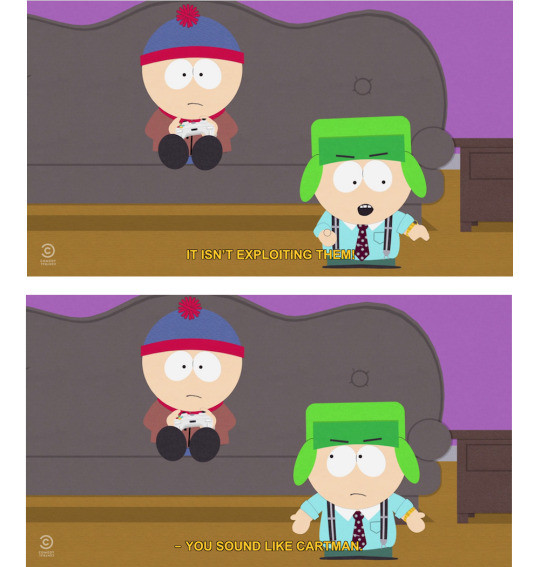
Pictured: Kyle justifying crack baby basketball to Stan (top), Stan retorting that he sounds like Cartman (bottom). Both from “Crack Baby Athletic Association.”
An equivalent example for Stan is “Butterballs,” when he gets so swept up in his movement against bullying that it becomes dangerously good at inflating his ego when his campaign goes viral. Kyle repeatedly tries to pull Stan down from the high of his fame, but when Stan doesn’t really listen to him, he just gets frustrated, and actually ends up predicting the future (“…when you’re naked and jackin’ it in San Diego, don’t ask me for help!”).
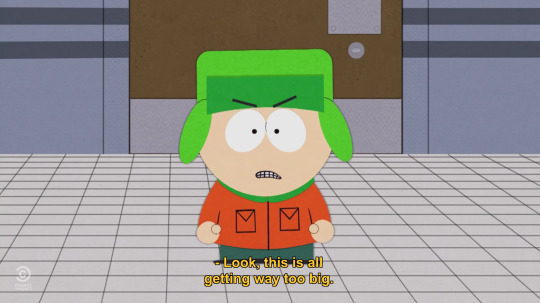
Pictured: Kyle taking a stand against Stan in “Butterballs.”
These are just two examples of times where these two have attempted to ground one another when they caught them going too far into something. So if there is a trend of them doing this for each other, why have they been neglecting to do this in the most recent episodes? What we came up with was how we defined their core characteristics, and how they act differently based on these two things: Kyle acts on sympathy, and Stan acts on empathy.
We came to the conclusion that Kyle acts on sympathy based on his previous interactions throughout the show, but most noticeably in how he reacts to Cartman in times of trouble. In the episode “Jewpacabra,” Kyle helps Cartman out of the hole he’s dug himself, even though he is the apparent target of Cartman’s antics. There have been several other instances of Kyle coming to Cartman’s aid, despite being Cartman’s favorite punching bag. This speaks to not only his strong sense of morality, but also to his sympathetic roots- Kyle feels bad for him so he wants to help him, because he thinks it’s the right thing to do. Kyle feels bad for the babies in “Crack Baby Athletic Association,” and so he wants to do something to help them and it appears that Cartman is doing that with his organization. With this in mind, the reason that Kyle didn’t want to get involved with Stan’s drug problem was because he didn’t feel sympathy for Stan’s situation. He held Stan to the standard that he understood that what he was doing was wrong, along with his own previously-seen inclinations toward self-preservation and apparent lack of empathy (”You’re Getting Old”/“Assburgers” are a good example of Kyle deciding to preserve himself instead of help Stan with his problems). Stan was stuck in the situation with his grandfather because he didn’t feel like he could just leave it as-is and risk his grandfather’s life. Because Kyle also didn’t see the threat to Stan specifically, he didn’t see a reason to feel bad for him and act.
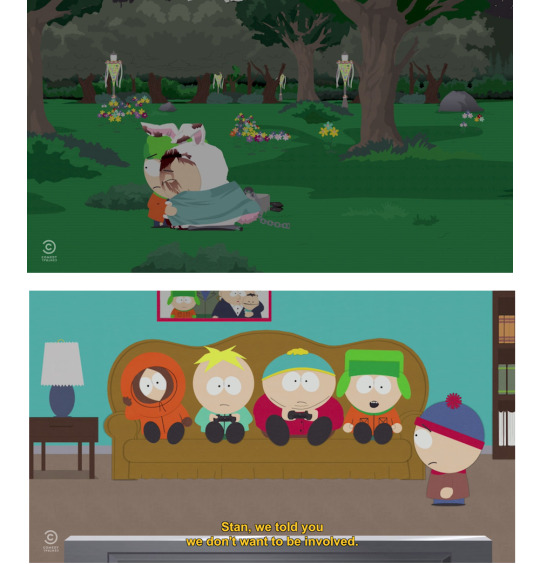
Pictured: Kyle leading Cartman home in “Jewpacabra” (top), Kyle brushing off Stan’s cry for help in “Hummels and Heroin” (bottom).
We concluded that Stan is, contrastingly, largely motivated by empathy, which is most easily seen in how he reacts to various forms of activism, such as his involvement in saving the whales in the episode “Whale Whores” and the calves in “Fun With Veal.” Stan reacts to situations based on how he would feel in someone’s shoes, the textbook definition of empathy. Another great example would be the episode “With Apologies to Jesse Jackson“ where he spends the entirety of it trying to understand Token’s feelings before realizing he could never fully understand as a white person. This was him admitting that he couldn’t fully empathize, which he struggled to do for the entire episode before finally ‘getting’ it. In the case of “Butterballs,” Stan initially felt a drive to do something about bullying to help Butters. Even though his intentions didn’t stay pure, the fact remains he felt empathetic for Butters’ struggle as a victim of bullying where none of his other peers around him did the same. Under this lens, the reason Stan did not feel inclined to help Kyle figure out the deal between Heidi and Cartman in “Doubling Down” is because Stan could not empathize with Heidi’s situation or Kyle’s concern for it. He didn’t try to do so either, so he was largely disinterested in the problem where Kyle was intent to change it (note that Kyle’s sympathy/morality motivated him here- he felt bad for Heidi and thought intervening was the right thing to do.).
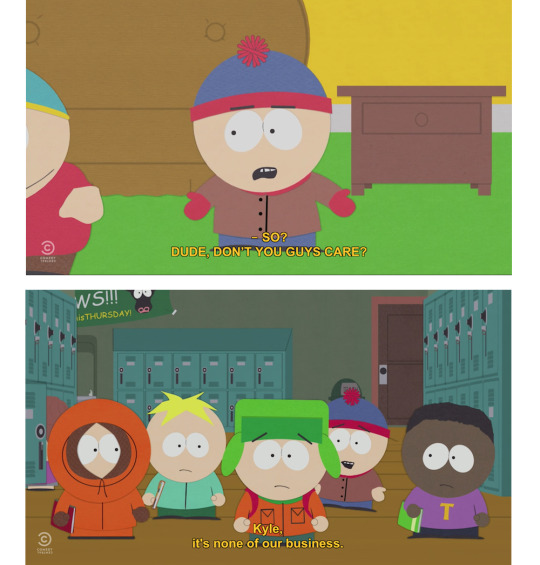
Pictured: Stan asking for assistance in saving the whales and dolphins in “Whale Whores” (top), Stan telling Kyle it’s not their business to intervene with Heidi and Cartman in “Doubling Down” (bottom).
Stan has historically shown more signs of being extremely loyal to Kyle in a way that Kyle has not always reciprocated, which the sympathy vs. empathy claim could also contribute to. With Stan’s connection to Kyle more emotional and his approach to life more empathetic, it makes him appear inherently more loyal to his friends. His ego can get out of hand if unchecked and he can get selfish at times, but more often than not his initial reaction to things is in regards to others as opposed to himself. He was ready to donate his kidney immediately upon learning that Kyle may need it to live in “Cherokee Hair Tampons,” even with the disclaimer of “even if it hurts a whole lot.” In comparison Kyle left Stan hanging at the end of ”You’re Getting Old” (mentioned earlier), expressing that Stan was “a bummer to be around” and that he couldn’t be a part of it as opposed to sticking with Stan to help him out of his funk. While this speaks to Kyle’s tendency to self-preserve more than anything, it also shows a lack of empathy when faced with his best friend’s struggles.
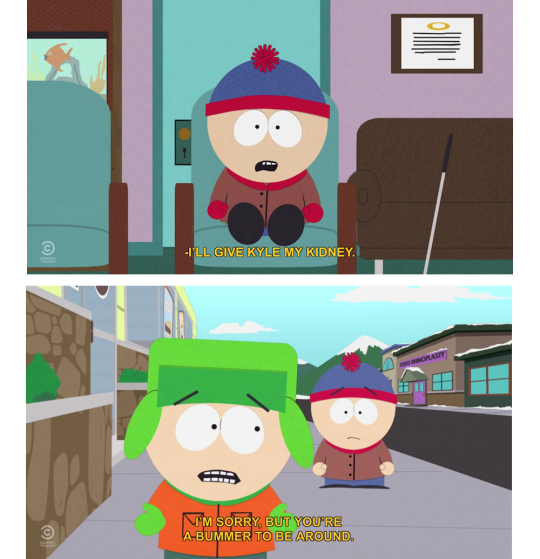
Pictured: Stan offering his kidney for Kyle in “Cherokee Hair Tampons” (top), Kyle expressing that Stan has changed negatively in “You’re Getting Old” (bottom).
Even though these theories help explain why they seemed despondent toward each other’s difficulties in season 21, it’s still apparent that the two of them have grown apart. Kyle has, throughout season 20 and season 21, been making some pretty big, potentially faulty decisions, and it’s my own theory that the reason he continues to make these embarrassing mistakes or choices is because Stan hasn’t been there to ground him the way he has in the past. Without someone next to him to help keep his head clear and conscience focused, Kyle goes off the rails with his ideas and his actions, and I’ve found myself thinking, ‘what are you doing?’ more than once. Without Stan, Kyle is out of control, and it just goes to show how dependent they really are upon each other as a unit. If Stan and Kyle were still close, I feel as though Kyle may have been much less involved in the more recent dramas of the show with Stan there to help rein him in. While the same claim can’t 100% be made for Stan, the reason for this is mostly that Stan has not had nearly as much time in the spotlight as Kyle more recently, so it’s hard to say how their drifting has affected him as well based on canon evidence. I find it significant, however, that in the finale for season 20, Stan was dashing out of his seat at a moment’s notice when Kyle requested something of him that seemed urgent- a show of his intense loyalty even when seemingly not as close as before.
With all of this said and done, it helps make Stan and Kyle’s recent reactions to one another a little easier to swallow for me, knowing that it could potentially boil down to their characters and not purely because they’re no longer interested in each other. It felt as though we had solved a puzzle coming up with this possibility. Do you think we’re totally off the rails with this one? Feel free to respond!
#meta#stan marsh#kyle broflovski#south park#south park meta#discussion post#long post#who am i kidding#it's a fucking essay#character analysis#super best friends#not shippy
592 notes
·
View notes
Text
ALL RIGHT. HERE WE GO. DISNEY PRINCESS HOGWARTS HOUSING LET’S FUCKIN’ GOOOOOO
I DON'T GIVE A FUCK. BEEN ON A HOGWARTS HOUSE KICK. LET'S DO IT. IN ORDER. ALL OF THEM. WITH ACTUAL GOOD REASONING.
MY HOUSING METHOD IS AS FOLLOWS
The Houses are separated using two different axes. The first is Aggressive vs Passive. This axis dictates whether a House is primarily an active participant in life who doesn't want to "settle for less" or more likely to just go with the flow and take the hand dealt to them, Hakuna Matata style. The Aggressive Houses are Gryffindor and Slytherin. The Passive Houses are Hufflepuff and Ravenclaw.
The second axis is Society Accepting vs Society Rejecting. This axis dictates whether a House sees itself as a member of society and acknowledges it's rules (even if it doesn't always follow them), or sees itself as an outlier to society, thinking that the rules need not exist at all (whether they agree with them or not.) TO BE CLEAR: REJECTING DOES NOT MEAN YOU ARE A LONELY SOCIOPATH AND ACCEPTING DOES NOT MEAN YOU ARE A MINDLESS YES MAN. The Society Accepting Houses are Hufflepuff and Slytherin. The Society Rejecting Houses are Gryffindor and Ravenclaw.
So, you find out on which side of each axis you land on. Most important, though, is to remember that your House comes from the WHY behind your actions, not the actions themselves. So, along with their full axis orientations, here is the main WHY behind each House:
Gryffindor: To spread their specific core values through their actions. (Aggressive Society Rejecting)
Hufflepuff: To be useful to humanity in every situation. (Passive Society Accepting)
Ravenclaw: To do what they want, when they want, as much as they want to. (Passive Society Rejecting)
Slytherin: To realize their dreams and become the greatest version of themselves they can. (Aggressive Society Accepting)
So, without further ado, here is my Housing, below the cut.
Snow White - Hufflepuff

This one will likely go undisputed. First off, is Snow White Aggressive in her story, or Passive? Well, Snow White is one of the queens of taking what she’s given and making it work. She dreams at her wishing well for her Prince, but she’s found a way to make her current life as a scullery maid bearable. She pretty much rolls with the punches from beginning to end. Evil Queen makes her a scullery maid, she’s gonna make it work. Huntsman tells her to run, she’s gonna make it work. Winds up living with a bunch of dwarves, she’s gonna make it work. This narrows her down to either Hufflepuff or Ravenclaw.
Second, is Snow White Society Accepting or Society Rejecting? Does she see herself as a valuable member of humanity as a whole, connected to everyone, or is she an island, separate and different from those around her? I’d easily say she’s Accepting. She believes in helping and doing her share and wants to be seen as useful. This would make her a Hufflepuff.
So, is Snow White’s WHY “to be useful to humanity in every situation?” I’d definitely say so. She’s very determined to do her part and to never be a burden. She is hardworking, often seen with her nose to the grindstone, and sees no job as being beneath her. It’s a job and every job needs to get done. Hufflepuffs often see the world as a giant machine, made up of millions of cogs. The only way the machine can work is if every cog is working at tip top form. So, Snow White is always at tip top form, always humble, never extravagant or over the top. She’s practical and sensible and gets the job done.
Cinderella - Hufflepuff

Very similar story to Snow. The basic moral of both of their fairy tales is “if you are hardworking and patient, good things will come your way.” So, first, is Cindy Passive or Aggressive? I’d argue Passive. Yes, she does eventually escape the clutches of Lady Tremaine, but that is only after she had an out handed to her. For all the time before then, she had been content with dreaming of her escape. More important to her was sticking it to her family by keeping her composure under her dire circumstances. She would remain passive and stoic, fighting their cruelty by never letting them see how it affected her. Her defense was becoming a rock; immovable, unbreakable, and ultimately Passive. This makes her either Hufflepuff or Ravenclaw.
Second, is she Society Accepting or Society Rejecting? I’d definitely say Accepting. She sees the caste system within her household as something to be worked through and endured, rather than rejecting it altogether and being rebellious. She doesn’t think she is someone who SHOULD be invited to the ball, although she still wants to attend. And even when she gets a chance to go, she worries about societal concerns; she can’t go unless she has a dress, some shoes, a coach, etc, not because she is selfish (quite the contrary), but because these are the things people who attend balls have. This would officially make her a Hufflepuff.
As a Hufflepuff, is Cinderella’s WHY “to be useful to humanity in every situation?” Absolutely. Cinderella is just as hardworking and humble as Snow White, if not a bit less trusting. Cinderella never does anything halfway, even if she doesn’t like the person who gave her the task. The task needs to be done, regardless of who assigns it to whom. Being a productive and useful human being matters most to her, to rebel and not complete these tasks she perceives as important would be much worse than her own suffering. It takes her Fairy Godmother reminding her that gaining her own happiness is the most important task to complete for her to begin wanting to change her situation.
Aurora - Ravenclaw

Our first different princess! So, to go back through my process, is Aurora Passive or Aggressive? Ultimately, passive. She shows much more outward discomfort in than both Snow White and Cinderella when things don’t go her way, but she still tends to just go with the flow. Although she cried on her bed about not getting to see Phillip, she accepts what has been given to her and goes with her fairy guardians. She was very content with just living in her cottage with her guardians in the middle of the woods. No need for anything beyond that. It’s the hand she was dealt, and she is content. So, she’s either a Hufflepuff or a Ravenclaw, like the others.
Now, here comes the surprise. Is Aurora Society Accepting or Society Rejecting? I honestly believe that Aurora rejects society and its norms. A Society Accepting type, after learning they were actually a princess, would feel sad that they couldn’t be with the boy they just met that day, but would take on this new task handed to them with grace and gusto. A Society Accepting would have been shocked, maybe scared, and then determined to become a good princess. Their new boyfriend would have entered their mind as another obligation, most likely as an afterthought, but they ultimately would have seen this new task as more important. Duty over desire. Not Aurora. Aurora is horrified to hear of her status as a princess. She mopes over it to no end. Why? Because, she had a dream about wanting a boyfriend, got a boyfriend, and now “society” and it’s “norms” are telling her she can’t have it!! What?? Who cares if she’s a princess and has “responsibilities.” She just wants to keep on living in her cabin with her forest-boyfriend. She only accepts becoming a princess after she realizes she gets to keep her guy. There isn’t very much to work with character wise with Aurora, but of the little she did, I just couldn’t find an example of her wanting to participate as a productive member of society. She just wanted to dance around with her forest friends. This would mean she must be a Ravenclaw.
Now, as a Ravenclaw, is Aurora’s WHY “to do what she wants, when she wants, as much as she wants to?” I would say YES. Since she is the first Ravenclaw, I’ll go a little deeper. Ravenclaws, due to being Passive and Society Rejecting, are usually best described as.... odd. They are usually found off in their own world, doing things in their own way, at their own speed. They feel no yearn to connect with society as a whole and would rather be doing their own thing. There are lots of things about Aurora that would seem “odd.” Her reaction to finding out she’s a princess is definitely entirely unique to her. Ravenclaws will very often leave the people around them confused with their reactions to things that society (or in the case of Gryffindors, morals) would deem as important, often shrugging them off or finding them outright abhorrent. Meanwhile, they laud some of the strangest achievements, like finding your Literal Dream Boyfriend, as more important.
Ariel - Slytherin

Yep. I know. Waiting for the debates. But, anyway, let’s start from the beginning. FIrst off, is Ariel Passive or Agressive? She is our very first Disney Princess I’d describe as Aggressive. She never accepts the hand that’s dealt to her if she doesn’t like it. She fights and she negotiates and she’s always looking for a way out of her situation. She is everything except Passive. No one would disagree to that.
Now, for the debate. Is Ariel Society Accepting or Society Rejecting? Now, most of you are probably thinking, “What are you, nuts? Of COURSE she’s Society Rejecting! She turns her back on the merfolk without a second thought! She sees herself as an outcast, an outsider! She’s textbook Society Rejecting!” But, I think I need to be a bit more clear about what I mean by “society.” “Society”, as defined in this axis, is not a place, it’s an idea. I guess what I actually mean by society is “connection.” Ariel is simply rejecting one connection for another, one that she finds more fulfilling. Hufflepuffs and Slytherins yearn for connection, for belonging, for validation. They need other people. They need “society”, as an idea. Gryffindors and Ravenclaws do not NEED connection. They may like it, it can be nice to have, but it isn’t required. If anything, the more Gryffindors and Hufflepuffs can differentiate themselves from everyone else they’ve ever met, the better. They want to be seen as different, unique, apart, unlike anyone else. Hufflepuffs and Slytherins want to belong. They want to be seen as exceptional, better, the best, even, but the only way to be that is to be able to be compared to someone else. So, yes, Ariel rejects merfolk society and scoffs at their rules, but she is OBSESSED with fitting into human society and following every one of their customs to a tee. Therefore, keeping all this in mind, Ariel is most likely a Slytherin.
Knowing that many of you still think she is a Gryffindor, let’s compare the WHYs of each House. Is Ariel’s WHY “to spread her specific core values through her actions?” Gryffindors are often the people you find lecturing those around them. Gryffindors are just brimming with advice, and they believe that everyone should just reject any rules that any society would place upon you and, instead, live the way they do. Exactly the way they do. And, here’s how you can do that (whether you want to hear me explain it or not!) Just look at the moralizing Gryffindors from the actual books to compare. Even Fred and George lecture, it not being enough for just them to be goofballs. They think EVERYONE shouldn’t take life seriously, just like they do. Ariel is not a lecturer. She has no grand message to share. Sure, she has morals, everyone does, but she doesn’t try to force anyone else to think the way she does. She doesn’t go around trying to convince anyone else that humans aren’t barbarians unless they start trying to stop her from bettering herself. They can think however they want, they just can’t stop her from thinking the way she wants.
Now, let’s compare. Is Ariel’s WHY “to realize her dreams and become the greatest version of herself she can?” Absolutely! That’s her entire existence. She wants to be where the people are. She wants to not only be human, but to be the BEST human. She wants to learn everything they know and more. She longs to follow their rules and customs, to belong with them. She sees becoming human as the best possible version of herself. This is the difference between the two Society Accepting Houses. Hufflepuffs, being Passive, accept the society they are given. They are realists and pragmatists, wanting to follow and practical, respectable life. Humility is their middle name. But, Slytherins, being Aggressive, don’t always accept the society that’s been handed to them. They want the best they can get and they will do whatever it takes to get that. If the Slytherin does accept the society they are born into, they will quickly try to become the best they can be within that society. They don’t just want to be useful, like Hufflepuffs. They want to be exceptional. Ariel wants to be exceptional. She wants to better herself. She wants to belong. And she does whatever it takes to make those dreams a reality.
Belle - Ravenclaw

After that last controversial one, let’s get a conforming House in here! So, let’s start. Is Belle Passive or Aggressive? I’d say that Belle is a great example to show that “Passive” does not mean “pushover.” Anyone can stand up for themselves and their own personal morals. Belle does this constantly. She stands against diversity and holds her head high where others might bow down. This sort of behavior is not House specific. But, Belle still shows that tell-tale Passive behavior. Although she may dream about getting out of this “provincial life” she seems more content to just accept where she is and make it work. She shows no signs of true rebellion. She can’t escape in real life, so she escapes through her books. This is enough for her. Then, when the Beast makes her his prisoner, rather than trying to escape, she makes it work. She makes friends with the servants, and takes pleasure in defying him so long as he’s rude to her, but otherwise, she makes it work.This would make Belle either Hufflepuff or Ravenclaw.
Now, is Belle Society Accepting or Society Rejecting? I’d say Rejecting. Although she dislikes people being cruel to her, using words like “odd”, she seems to take some pride in being different from them. Although she longs for friendship and belonging, what she really wants is to find people who will let her be who she wants to be. She enjoys things that are different, like her, and wants to exist alongside them. Yes, some Society Rejectors can exhibit this ironic behavior. They align themselves with other people who are “odd” or “different” and seemingly form a new society. But, what’s important to remember is that there’s a difference between seeking “belonging” and seeking “acceptance.” Society Rejectors want to be accepted, meaning that they are left to behave how they want and get to keep their friends. Society Acceptors want to belong, meaning they strive to become good enough that they may be part. So, Belle must be a Ravenclaw.
Now, as a Ravenclaw, is Belle’s WHY “to do what she wants, when she wants, as much as she wants to?” I would say so! She wants adventure, she wants to read her books, she wants to be different, she wants to exist as an individual alongside other individuals. I think she falls in love with Prince Adam BECAUSE he’s so unique. He’s different. The more she recognizes him as an outcast, the more she likes him. The more she sees how unique the castle is, the more she likes it. Therefore, she exhibits some strange Ravenclaw reactions: She chooses to stay in her captor’s castle, even forming a loving relationship with him, all of her own volition. This is definitely a unique response to everything that happened to her. I considered Gryffindor briefly, but I think the live action movie may have an example of a Gryffindor Belle. She tries to escape. She is more of a lecturer. She actively teaches the Beast to be a better person, rather than bonding with him exactly as he is in the animated version. Live Action Belle tries to teach other girls in the village to be inventive and educated, Animated Belle is not going to force anyone to read with her. If they don’t want to of their own accord, she’s not interested.
Jasmine - Gryffindor

I don’t think this one will be disputed. So, firstly, is Jasmine Passive or Aggressive? I think we’d all say Aggressive. She is a doer, a changer, she is willing to rebel if she feels like she’s not getting treated the way she should. She sics a tiger on a suitor. I really don’t think I need to give any examples beyond that. So, that makes Jasmine either a Gryffindor or a Slytherin.
So, is Jasmine Society Accepting or Society Rejecting? I’d pretty clearly say Rejecting. She doesn’t just dislike royal society, she just flat out hates the idea of anyone telling her what to do. She enjoys standing out and being different, being “not the average princess.” In her speech to Aladdin, she mentions feeling trapped by society’s rules and regulations. She wants to be an individual, to be free. So, that would make Jasmine a Gryffindor.
Our first Gryffindor Princess! So, as a Gryffindor, is Jasmine’s WHY “to spread her specific core values through her actions?” I’d give that a big yes. She is the first lecturing Disney Princess. She lectures her father on her beliefs after siccing Rajah on her suitor. She will only marry for love. She not only seeks to free herself from society’s norms, but others as well. She frees her pet birds from their cage, she steals an apple for an orphan, and she tries to free Aladdin, although societal rules say that he should be punished for the crimes he actually committed. She makes speeches and tries to push her beliefs onto others, while trying to live by example.
I’ve decided I’m going to do a part two!
For some of the upcoming princesses, I think I’m going to have to meditate a bit harder. As the storytelling gets more complex and less old school fairy tale, the princesses get more complex. And, since it’s getting late, I’m going to think on it a bit longer and finish this another day. Expect a part two! Thanks for reading this short novella!
#non-mbti#hogwarts houses#Harry potter houses#HP houses#Disney Princess#hufflepuff#ravenclaw#slytherin#gryffindor#cinderella#sleeping beauty#belle#ariel#little mermaid#jasmine#sorting hat#hogwarts sorting
302 notes
·
View notes